« May 2005 | Main | July 2005 »
June 30, 2005
Monopoly Here & Now
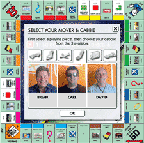
London as a Real-Life Playing Board
"We have turned London into a real-life playing board, and real taxi cabs into real-life playing pieces. All you have to do is make as much money from rent as possible, from five other cabs who are your opponents in the game. We've kitted out 18 cabbies with GPS (Global Positioning System), meaning we can pinpoint their exact whereabouts in London. They will be going about their normal day, picking up and dropping off customers all over town. All that you've got to do is spend the £15m we give you on properties from around the Monopoly Here & Now board, distribute your apartments and hotels and choose your cabbie. You are placed into a game with your cabbie and 5 other taxi drivers, all travelling around London. Every time one of the other cabs stops outside one of your properties, you get paid rent. Any time your cabbie lands on a property you don't own, you pay up. Simple!"" [via smartmobs]
Posted by jo at 11:06 AM | Comments (0)
WifiPicning
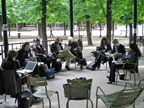
Bridging the Real and the Virtual
"...Just like a flash mob, the wifi bubble constitutes a small, short-lived and friendly community, mixing the real and the virtual, a kind of happining. In the context of shared activities, the wifi bubble possesses big potential and opens up the possibility of amusing and unexpected perspectives. Natacha, Sacha, Tristan et Tatiana have a lot of ideas for developing the concept : inviting a well-known personnality to speak via the chat with those present. Sharing files, multiplying proposed services ; A DJ performing live in the bubble for a mini-concert outside. Participants could write a story together, chat on the beach, in the mountains, in a museum, in a night-club, in a library, in the middle of a field, in a café, in the street…
Two and a half hours later, it was over. We shut our lap-tops and promised to blow another bubble this summer in Paris, in Maussane les Alpilles (near Les Baux de Provence) and in Normandy. We were delighted, everything went well. We were fifteen. The experiment was a success. The atmosphere was so convivial we cannot but begin again. And we are not alone, Bresilians on the web are already talking about launching sparkling bubbles under a southern sun." From The First WifiPicning Review [Related: Story of the Bubble] [via smartmobs]
Posted by jo at 10:54 AM | Comments (0)
Foundcity
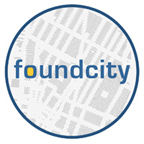
The Dynamic Nature of Place and Space
From The Feature: "...many projects have approached the idea of annotating space before but few have succeeded as well as FoundCity in giving this networked effort a more personal quality. By overlaying the perspectives of thousands of people, FoundCity approaches the dynamic nature of place and space."
Foundcity--by John Geraci, Christina Ray, and John Schimmel--is a social mapping tool for creating a personalized map of your life on-the-fly. Using your mobile phone, you "tag" or capture photos throughout the day, label them with any words you want, and send them to your map. At home, you access and customize your map, which you can share with friends, keep private, or publish openly. As a visitor to the Foundcity site, you view a map of all tags and connect with the people and places that share your interests. By plugging in to the network of Foundcity users, you learn what others value in the city as you surf their hotspots. By publishing your own tags, you share what you know about your city.
Posted by jo at 10:35 AM | Comments (0)
June 29, 2005
Speeder Reader
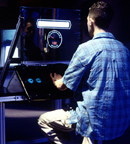
An Experiment in the Future of Reading
"ABSTRACT: Speeder Reader is an interactive reading station built around two primary ideas: dynamic text (especially RSVP, that is rapid serial visual presentation), and the interface metaphor of driving. As words flash one at a time on a screen in front of the reader, he or she controls the rate of speed of the words with a gas pedal (up to 1850 words per minute in the current instance). Text stream selection is performed with a steering wheel. Thus, one can "drive through a book." We leverage people's knowledge of the familiar activity of driving an automobile (or, in the case of children, operating a speed-racing video game) to allow comfortable and intuitive access to a possibly less familiar world of interactive text. We emphasize the power and ease of the familiar driving metaphor as a navigation device. Speeder Reader was first installed at the Tech Museum of Innovation in San Jose, California, as a part of a larger exhibit on the impact of digital technologies on reading." From Speeder Reader: An Experiment in the Future of Reading [PDF] by Maribeth Back, Jonathan Cohen, Rich Gold and Steve Harrison.
Posted by jo at 10:02 AM | Comments (0)
June 28, 2005
Step + Repeat: Pittsburgh Cycle
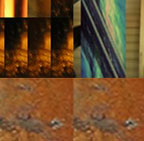
Shifting Technologies and Economies
Step + Repeat: Pittsburgh Cycle--by Carlos Rosas and Robert Dansby--Call for Participation: Submit your images of Pittsburgh. Your images will be entered into the image database and be included in the participatory tile sequence projected in the Palmer Museum and viewable on the Internet via live webcast. For more information on this project, to submit images and to view the live broadcast visit the project web site.
Abstract: A live audio and video based piece using networked media. Based on digital “step and repeat” cycles: a loose metaphor, the Pittsburgh iteration uses video and audio samples recorded in Pittsburgh, PA, and the surrounding western Pennsylvania area –with touchpoints including Primanti’s, the Strip, the Southside, East Liberty, the Northside, Beaver Falls, Jones & McLaughlin, the Monongahela Incline and Pittsburgh’s three rivers.
Divided into into six primary segments and a seventh segment including material contributed by viewers to be filtered through a digital randomizer, step and repeat: Pittsburgh cycle maps entrance into an urban environment via incline railway, transit through the city, reflections of the community’s industrial past, particularly steel, and the transformation of city and countryside as the industrial economic base shifts and nature again takes hold of old worksites. In the last two segments the viewer leaves the city, again on incline railway, and watches as the evening paints the city as a visually appealing study of water and reflection.
Concept and Development:
With a nod toward Allen Sekula’s work: specifically “Fish Story.” This piece chronicles (in a documentary fashion) the ironies, displacements, shifting values, economies and systems: the transformation of an American city as an industrial and economic center shifting from steel to telecom, and the reclamation of areas of the city and countryside dedicated to old economies/technology by both nature and the population at large - a population with new needs but retaining a core identity.
The “Step and Repeat” cycles are variable and highly dynamic works performed live with laptops or in automated modules prepared for web or installation on site. The media resources are mixed, filtered, and emitted via live performance software…deriving image, video, qtvr, audio, and net streams from databases and databanks resident on local and networked laptops and servers.
Posted by jo at 12:21 PM | Comments (0)
Fluxus
Live Coding
Fluxus: act of a flowing; a continuous moving on or passing by, as of a flowing stream; a continuous succession of changes. Fluxus allows you to write Scheme scripts that create graphics live, interpreting audio and OSC input as a source of animation data. Fluxus also uses a fully featured physics library, which means you can script physical properties into objects and simulate them in realtime. Released for Linux under the GPL licence.
The built in scheme code editor runs on top of the renderer (see screenshots), which means you can edit the scripts while they are running. This allows Fluxus to be used for livecoding performances, or simply as a fast feedback way of experimenting or learning about graphics and animation. Fluxus lends itself to procedural modelling and animation, there is no model import functionality, only simple primitives. There is an expermental procedural modelling tool however, and full support for texturing and basic material properties.
Posted by jo at 10:54 AM | Comments (0)
PitchWeb
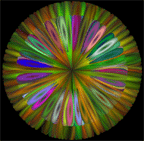
Jam this Wednesday
PitchWeb jam this Wednesday, June 29, from 6-8 pm EDT. The occasion is a book release party Routledge is giving for William Duckworth's "Virtual Music: How the Web Got Wired for Sound." They'll be playing as DJ Tamara and the Laptops. The plan is to make the party a "virtual" experience: the party goers have been invited to bring their laptops, and Nora will be weaving the online band into Tamara's house mix and a webcast.
Hope you can join them online at http://www.pitchweb.net/. All you have to do is click, sign on, join a group, and play along. As with the 12-hour May-Day PitchWeb jam, Wednesday's session will also become source material for the yearlong Deep Time: Songs for Servers project that we're beginning later this year.

About the Book
· Must-reading for all interested in the world of web-based music
· Highlights diverse artists from John Cage to Moby to Scanner
· Includes unique CD sampler highlighting the composers and works discussed in the book
Virtual Music: How the Web Got Wired for Sound is a personal story of how one composer has created new music on the web, a history of interactive music, and a guide for aspiring musicians who want to harness the new creative opportunities offered by web composing.
For Bill Duckworth, the journey began in 1996 when he developed the idea for an interactive webcast, named "Cathedral," which was developed over a period of 5 years. On its completion, "Cathedral" won numerous awards, including the ASCAP/Deems Taylor Award for composition, and has already inspired further experimentation.
But this is more than the story of one composer or one piece of music. The book traces the development of interactive music through the 20th century from Erik Satie through John Cage, Brian Eno, Moby, and Scanner. The technology itself is described as it has inspired experimentation by artists, including composers who have developed new ways to involve the audience in their music, plus possibilities for the non-musically trained to "play the Web." Challenges facing the web composer-from copyright issues to commercialization-are analyzed with new solutions suggested.
Virtual Music is a fascinating story that will appeal to fans of new music, creators, performers, and anyone interested in how technology is transforming the arts.
Posted by jo at 08:45 AM | Comments (0)
Tune Me
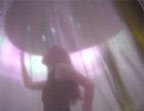
Multi Sensorial Radio
Tune Me is an immersive conceptual radio based upon tactile features. The sound and the visual are triggered by "touchy" interfaces. The visitors enter the ellipse-shaped space, immersing themselves in a new world where to listen to the radio waves.
As well as the sound, each channel provides light features as well as vibrating and pulsing experience. When choosing the different FM stations, the overall space changes, defining different moods upon the nature of the different content. News, sport, classical music and international pop. Each of them triggers a different visual experiences, the space vibrates, pulses and interacts with the visitors.
Developed by Line Ulrika Christiansen, Stefano Mirti and Stefano Testa (with Daniele Mancini and Francesca Sassaroli). More pictures by Stefano and Simone. Also part of Touch Me at The Victoria & Albert Museum (London) till August 29th 2005. [blogged by Regine on we-make-money-not]
Posted by jo at 08:18 AM | Comments (0)
Yellow Chair Stories

Free Access
With the Yellow Chair Stories, Anab Jain opened her WiFi network to neighbours and passers-by. She placed a sign "advertising" the offer and a yellow chair outside her house, extending the boundaries of her home to encompass the boundaries of my wireless network. Both the sign and the chair defined a "real world blog space" which challenged the idea of "open network".
This "grass roots" design approach illustrates how wireless technologies could become interfaces to recreate transient spaces for conversations at the threshold of the public and the private, the physical and the electronic. Anab and Viktoria Klinker are also showing Sketch-a-move. [blogged by Regine on we-make-money-not]
Posted by jo at 08:14 AM | Comments (0)
June 27, 2005
NEIGHBOURHOOD GAMES
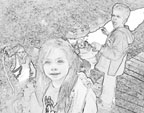
Transcending Existing the Boundaries
So what happens when kids come to the end of the level on their gameboys - what if they don't even have Gameboy? What is the fascination in sitting around in the park all evening? What is the most daring place you have seen tagged? Who decides when the game starts... and when it's over? What does a neighbourhood mean?
Neighbourhood Games--by John Paul Bichard--sets out to explore the possibilities of introducing cross-media games into the everyday neighbourhood environment, to propose ways in which games can be meaningfully structured across a broad range of channels, including fixed and mobile digital spaces and the "real" environment of the local neighbourhood.
Neighbourhood Games looks at ways in which gameplay normally associated with digital frameworks can be organised and played with or without these technologies. Key to this are not only the motivations and rewards a game sets up but also the nature of that gameplay in relation to environment, the aspirations of the game players and the existing social organisation in a particular locale.
The aim is to explore games methodologies that have the potential to enable a range of players to engage in play scenarios that are situated in the everyday environment and how far these are able to transcend existing the neighbourhood 'boundaries'.
Posted by jo at 12:47 PM | Comments (0)
Air Beam

Beaming Text and Images in the Air
SK Telecom announced Monday that it would launch an Air Beam service that displays text messages or images in the air. You can spell out messages in the air by waving your handset after downloading relevant program. A total of 16 beamed messages can be stored in the handset and a variety of emoticons are downloadable on Nate, SKT’s portal website. An acceleration sensor is deployed and the messages can be seen up to 20 - 30 meters away. [via Telecoms Korea]
More on air texting/wave messaging:
-- SMS Messages in the Air - Sun Data, a handset accessory company, announced it developed AirBeam that can display SMS or image stored in handsets in the air using LED. (December 2004).
-- Wave Messaging - By waving the Nokia 3220 camera phone from side to side, the LED lights of the Nokia Xpress-on FunShell light up to "write" a message that appears to float in mid-air (May 2004).
-- In March 2003, the WSJ reported from CeBIT about a phone called Kurv, made by Kyocera Wireless Corp which featured airtexting: "The company believes airtexting will be one of it's most popular features, especialy in night clubs. To airtext, you type in a text like 'call me' then wave it back and forth in the air. As the phone moves, a row of blinking red lights along the top of the phone leaves the phrase trailing behind it."
-- A company called Wildseed actually tested airtexting with teenagers - which was a big hit. cf post in Textually on airtexting.
-- And an article from Wap.com (no longer online) several years ago, featured a California company called Neoku.com which developed a platform called haikuhaiku. The article described a form of mobile graffiti, using a cell phone as a paint spraycan, "by waving it into the air to form a word, the text would appear onto the screen of a person passing by".
Audio interview explaining smswave [blogged by Emily on textually.org]
Posted by jo at 11:59 AM | Comments (0)
Let's get loud!

Interview with Helen Thorington
"They began with the radio, producing over 300 projects in 15 years. Then while it was still the dawn of a new genre, they started with net art. Today, Turbulence.org has around eighty net projects running, many of these making history in net art. With an enthusiasm and energy that's hard to compare, they continually enrich their collection in which one of the most important and most visited blogs of those dedicated to the relationship between creativity and new technology can be accessed. It doesn't have a physical space, but it doesn't need one, considering it can boast to be one of the most interesting places on the web. We asked the artist and co-director of Turbulence.org, HELEN THORINGTON, the project's backbone right from the start, to tell us the story, enlighten us on the structure and the problems it has had to face and to take a glimpse at what the future has in store." From Let's get loud!: Interview with Helen Thorington by Domenico Quaranta, Cluster.
Posted by jo at 10:48 AM | Comments (0)
Connectivity Probes
![]()
Experiments in Social Networks
"Connectivity Probes is a two year (2003-5) research project comprising a series of objects, installations, and systems that explore the expanding potential of digital tools in communication mediums...The focus of the project is to provide inspirations for new directions in communication systems of the future or s of interaction in shared public space (using wired and wireless networks) and to develop new forms of asynchronous communication spaces.
...We define a "connectivity probe" as a sort of cultural or technology probe that specifically involves connecting two people or locations in an unexpected or provocative way with the hope of revealing unusual behaviors and inspiring feedback that may provide insight into the nature of human communication and serve as a resource for creativity and ideas in the development of new communication technologies. In its purest form, a "connectivity probe" is not a "prototype" that is meant to be formally analyzed and studied from a usability perspective in a process of iterative refinement leading to a product. Connectivity probes, like all probes, exist for the purposes of inspiration and feeding ideas into a design process in which the final products may take forms very different from the original probes that inspired them."
Posted by jo at 04:28 AM | Comments (0)
The Fantasy Life of Boys:

A Magical Tactical Practical
The Center for Tactical Magic is a San Francisco-based collective operating in the realm of performance (art) and action. Highly trained in the principles of magic, ninja-ism, art, investigation, and critical theory, the Center's actions represent a novel combination of serious political thought and social gathering. Presenting a model of art-making as collaborative, relational, and political, CTM has pseudo-military cousins in groups like Basekamp (Philadelphia) and Atelier van Lieshout (Rotterdam, The Netherlands).
MAGIC: Like artists, magicians and ninjas synthesize technical ability with tricky showmanship, competition, and illusion. The artist-as-magician illuminates the aspect of art presentation that works on the tiered levels of the public, the curator, and the fellow practitioner. CTM is able to entertain local children while foregrounding political statements and acts, rather than merely clowning. This works on the level of the public- and the artist-viewer, while entertaining and educating both.
BOYS: CTM encompasses a levity of approach which reflects its roots in fantasy careers like magician, ninja, private investigator, and philosopher. Many artists have taken on professional personae in order to document subcultures and social truths. The hybrid practice of CTM uses a schoolboy's list of professions as a tactical launching pad to pursue meaningful interaction and effective action.
NO MORE PRISONS: In the case of CTM, the various training in the ways of stealth reconnaissance, mind-and-body bending, and customer service, has yielded a powers-for-good scenario. The commitment to models of political action and literacy set this group apart from your average roving gang of fighter- trickster-private dicks. The CTM continues to take its message and methods to the streets, and to regional art centers and universities around the US.
Always up to something, I asked The Center to take a moment to offer a list of recommended readings to Rhizome Digest readers in lieu of a formal interview, and they provided the following five readings and five real-world exercises in their brand of Tactical Magic.
-Sara Greenberger
*************************************************************
READ-BETWEEN-THE-LINES READINGS: (in no particular order of preference)
1) Magick in Theory and Practice - Aleister Crowley (especially Crowley's preface/intro) and/or Magick Without Tears
2) Essence of Ninjutsu - Dr. Masaaki Hatsumi
3) Magic & Showmanship - Henning Nelms
4) Guerrilla Warfare & Special Forces Operations (FM 31-21) - Dept. of the
Army
5) The Temporary Autonomous Zone, Ontological Anarchy, Poetic Terrorism -
Hakim Bey
EXERCISES IN MAGICAL THINKING, ANALYZING POWER, AND ACTIVATING HIDDEN FORCES:
1) Plant three seeds of a vegetable plant of your choosing. Label each container respectively: positive, negative & control. Provide each plant with equal amounts of water, soil, and sun. Dedicate at least 6 minutes of each day (3 minutes per plant - positive & negative only) to focused positive & negative thoughts. Record your results and enjoy the fruits (vegetables) of your labor.
*This is an exercise in developing your telepathic abilities, exploring modes of unregulated communication, collaborating with non-humans, and bringing your thoughts and desires to fruition.
2) Write your own survey to elicit responses from other members of the general public. You may decide to pose questions, ask opinions, or provoke thought. Then, conduct the survey for at least 3 hours in a public space of your choosing, or until the "authorities" inform you that you are trespassing on public property.
*This is an exercise in activating public space, determining the limits of public space, and generating a non-commercial exchange of ideas among strangers. Most people are happy to express their opinions when asked, especially when they are informed that there participation does not involve a sales pitch, future mailings, religious conversion, or product development.
3) Get a rope (at least 30ft) and a friend (or a friendly stranger). Take turns tying each other up and escaping.
*This is an exercise that explores restriction, control, and self-liberation. You'll be amazed to find how easily one can liberate oneself!
4) Get a group of friends together at night and find a public space to beautify as you see fit. Consider your site beforehand and plan your action thoroughly (but don't bring along any evidence of your conspiring). Your materials should not be cumbersome, or they should be well-disguised. While some friends are in the act of beautifying, others should be posted on the lookout for "authorities" since they might not have the same sense of aesthetic appreciation as you and your friends. (Hey! If they don't like it, they can make their own art!) If you decide to document your actions, it's best to do it at a later time, and be sure that none of your friends faces are visible.
*This is an exercise in collaborative acts of meditation, willful engagement, and material transformation. You can do this in the daytime too, but nocturnal operations tend to be more mirthful and help induce perceptual shifts (both spatially and experientially).
5) Create a disguise for yourself that allows you to navigate everyday life without drawing much attention. This should be different from your normal attire. Spend the day in disguise performing leisurely or mildly adventuresome activities. Possibilities include:
a) Choose someone at random and follow them from a distance for at least fifteen minutes. Then follow someone else. When you grow tired of following people, find someone who looks lost and try leading them to their destination.
b) Visit a factory or place of industry and ask for a tour. Ask lots of provocative questions, then ask for a job. Tell them you can't do much, but you're interested in something at the executive level.
c) Go to at least three different places of worship. Check out the interior design. Explore a little. If someone is in attendance, strike up a conversation about the "afterlife" or "special religious foods."
d) Go to a bank with your video camera and ask the security guard or branch manager if you can record there. When s/he says "no" then ask how many security cameras they have installed. If they ask "why?" tell them you're "just doing research" or "conducting a survey of banks" or "interested in security."
*This is an exercise in shape shifting, personal transformation, and casting illusions as well as observing how "authorities" respond to subtle challenges beyond the status quo. The disguise will help empower you to act "out of character;" besides, if you can't change yourself how do you expect to change the reality around you?
-Center for Tactical Magic [via Rhizome]
Posted by jo at 04:12 AM | Comments (0)
June 24, 2005
Synthecology
![CWall_04[1].jpg](http://www.turbulence.org/blog/images/CWall_04[1].jpg)
Garden of Sonic Lifeforms
Synthecology, a tele-immersive collaborative project with a new architecture for virtual reality sound immersion to create a garden of sonic experimentation for visitors to explore and cultivate. Synthecology invites visitors to create a musical sculpture of sythesized tones and sound samples provided by web inhabitants. Upon entering the garden, each participant can pluck contributed sounds from the air and plant them, play their own improvisation or collaborate with others to create a new composition.
As each new "seed" is planted, grown, and played, the garden becomes both a musical instrument and a composition to be shared with the rest of the network. Every inhabitant creates, not just as an individual composer shaping their own themes, but as a collaborator in real time who is able to improvise new soundscapes in the garden by cooperating with other avatars from diverse geographical locations. Synthecology will debut at NEXTFEST2005 in Chicago, June 24-26, 2005. [blogged by Regine on we-make-money-not]
Posted by jo at 03:05 PM | Comments (0)
Chanel TV Belt
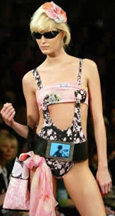
AttentiveTV
"Gadgets Gone Glamorous! None other than our beloved Karl Lagerfeld himself put his innovative mastermind to work to create this Chanel TV Belt. This gem was almost overlooked during this year’s Chanel Spring/Summer 2005 Runway Presentation, yet it is the item for any socialite this summer. Yeap, Karl is always good for some ridiculous magic out of the blue. And yes, the screens did indeed show Nicole Kidman’s ad while the models ran the catwalk. However, it is questionable that this gadget will ever hit the Chanel stores. A lady at the NYC store apparently mentioned it may stay runway only, but who knows with Chanel.
What more could this world need than more garnered attention and stares at peoples crotches? [blogged by Vlad on The Purse Blog] "...But what I love even more is the prospect of incorporating AttentiveTV (3.4MB .mpg) technology into the new Chanel TV Belt...Would it not be even more cheeky/mod if the Chanel TV Belt had the ability to know when someone was looking at it?..." [blogged by connor on HML]
Posted by jo at 02:43 PM | Comments (0)
The Story of Boris in 15 Sessions
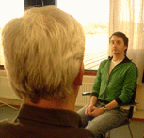
Collected Memories of a War Refugee
The Story of Boris shows the sessions of a traumatised war refugee with his psychiatrist. Edited sequences of the latest session will be uploaded weekly, along with other files on the history, treatment and life of the patient. This way a dossier is created to reconstruct Boris's past.
Boris is suffering from PTSD (post traumatic stress disorder) as a result of the war he fled from. Because of this disorder his story is fragmented. In order to recover, his memories and the reality of war have to be disclosed. What are the events that Boris went through? Which role did he play during the war? The audience is free to investigate Boris's past and present by browsing the files at this website and take an independent view in search for the truth.
Posted by jo at 02:24 PM | Comments (0)
The Infome
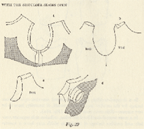
The Ontology and Expressions of Code and Protocols
"...(C)omputers are no longer interesting because they can simulate reality, but because they transform the written word into reality, a reality whose ontology is to be found in and between 'environment' and 'organism,' and even if the complexity of the network of networks and their data have not yet reached a threshold where the network actually transforms from merely a set of connected nodes to an entity worth describing as a totally new category, form, or dimension, a rich and fascinating set of issues and areas of research open up by claiming and solidifying it by giving it a name. I propose the term 'Infome' to denote this all-encompassing network environment/organism that consists of all computers and code. The term is derived from the word 'information' and the suffix 'ome,' used in biology and genetics to mean the totality of something as in chromosome or genome.
Within the Infome, artist programmers are more land-artists than writers; software are more earthworks than narratives. The "soil" we move, displace and map is not the soil created by geological processes. It is made up of language, communication protocols, and written agreements. The mapping and displacement of this "soil" has the potential of inheriting, revealing, and questioning the political and economical assumptions that went into this construction..." From The Infome: The Ontology and Expressions of Code and Protocols by Lisa Jevbratt, Crash, London 2005.
Posted by jo at 12:56 PM | Comments (0)
16 (R)evolutions
evssmall.jpg)
Exploring Polarities
16 (R)evolutions is a work in progress that can be seen for the first time in the UK at Colchester and in Chelmsford. It combines dance, theatre, and interactively generated video imagery to explore the polarities of being animal and being human; the former being dictated solely by the need to survive and reproduce, the latter being a state of confusion created when these basic instincts are blurred by intellect. Technologically Troika Ranch's Isadora software is integrated with EyesWeb to allow the dancers to create and manipulate three dimensional imagery as they perform. In the winter of 2005 the English company will be travelling to New York to complete work on 16 (R)evolutions and present the premiere of the completed work in New York City.
Posted by jo at 11:20 AM | Comments (0)
June 23, 2005
The GHI of Tactical Media
![]()
Art with a Captial A and Activism
"Abstract: Tactical media are the field being worked by artists adopting a positive attitude towards contemporary digital technology, in a critical, innovative spirit. Media artists reveal a preoccupation with aesthetics as a concept, not with a particular style. This trend is part of the creation of a new language for the communications network era, a user language which is successful as art because it transmits an effective activism. Media activists are a hybrid of artist, scientist, theoretician and political activist that shuns labels and categorizations. Their creations are characterised by integration of user and machine in the work itself, so that interactivity has an important place within it. The concept of tactical media allows Art with a capital and grassroots political activism to be combined and, in this sense, we could include in it the tactical struggle that is part of anti-globalisation movements. Media activists point to the power of tactics as a means of breaking down the barriers between mainstream values and alternative ones, between professionals and amateurs and even between people who are creative and those that are not." From The GHI of Tactical Media, conversation between David García, Geert Lovink, Andreas Broeckmann, Artnodes.
Posted by jo at 11:56 AM | Comments (0)
Digital Human Body Communication

Body Area Network [BAN]
Digital Human Body Communication was first unveiled to the public. It is also called as BAN (Body Area Network), as it handles communication between devices using the human body as a medium. Electronics and Telecommunications Research Institute (ETRI) said that although only a small amount of data, such as information on a name card, can be transmitted at the moment because the data transmission speed is just to be 2.4Kbps, the speed will be improved to 1MB within the yearend.
ETRI explained that BAN can be utilized in numerous ways, such as touch based authentification service, electronic payment service, e-business card service, and touch based advertisement service. [via Telecoms Korea] [blogged by Emily on textually.org] [Related]
Posted by jo at 11:14 AM | Comments (0)
TIME TRANSLATIONS
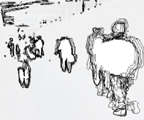
Pedestrian's Dance
Time Translations--an interactive installation by Nell Breyer-- transforms the World Financial Center's southern pedestrian bridge from a temporary structure to an animated performance space through the projected movements of passers-by. Cameras capture the constant movements along the bridge in real time, which are then processed by computer, and projected into the space as beautiful, ephemeral drawings on the walls fo the bridge. The daily activity of walking to work is visualized as a kind of dance in which pedestrians become performers. [Schedule]
Nell Breyer is currently a Research Affiliate at the Massachusetts Institute of Technology's Center for Advanced Visual Studies. She was a fellow at the Artist Resource and Media Laboratory (ARM) at Dance Theater Workshop in 2003. From 2000-2002, Breyer conducted research on digital video technologies at The Media Laboratory for Arts & Sciences at MIT. She holds an M.Sc. in Cognitive Neuroscience from Oxford University and an M.S. in Media Arts & Sciences from MIT.
Posted by jo at 10:30 AM | Comments (0)
June 22, 2005
Adopt A Chinese Blog

Cooperation, Politics and Activism
This idea is so brilliant it gives me chills.
Blogging is popular in China, enough so that the government is paying more attention now to what people say on them. Numerous blogs have been shut down, either from government pressure or just by Chinese host providers fearful of its users possibly breaking the law. In addition, an April 2005 law mandates that all non-profit website owners must register their sites with their real personal information. The recent revelation that Microsoft was censoring various terms in the blogging service they offer in China only added to the fear that free speech on the Chinese web would be harder and harder to find. Some Chinese bloggers managed to put their websites on offshore servers, but the language and cost issues are prohibitive for many.
Adopt A Chinese Blog is an end-run around official censorship. How? By making the hosting of Chinese blogs a distributed, collaborative process:
This is how it works. A blog (or any website, really) using an independent hosting service hosts a blocked blog. (This simply means creating a subdirectory where the adopted blog can be published and store its files.) The host blog should not have a significant readership in the country where the adopted blog is blocked, because the host blog is running a (small) risk of being blocked in that country. [...]
By distributing the blocked blogs across a variety of hosts, the task of blocking a large number of blogs becomes increasingly difficult. If any adopted blog is blocked, it can say its thank yous and farewells to its host and then move onto a new host.
If the multitude of Chinese blogs facing official censorship instead became hosted on a multitude of independent servers around the world, the Chinese government would end up having to block a significant portion of the net to shut them out -- and that portion would grow and grow as the blogs found new adoptive hosts. The traffic and maintenance demands on the adoptive site would likely be minimal, and the adoptee gets a host server free from government censorship.
I'd like to see an equivalent program for Iranian bloggers, or for bloggers/writers in any other country facing official restrictions on what they can say online.
People wishing to talk about this project in more detail can visit the Adopt Chinese Blog Forum. [blogged by Jamais Cascio on worldchanging]
Posted by jo at 12:11 PM | Comments (0)
Anne Galloway

Case histories (Mobile Bristol)
People have often asked me which of my case studies is the 'best' project - like they can be definitively ranked - to which I have always, and truthfully, answered, "I think all five are really interesting. That's why I chose them." **
"Cases are rarely chosen because they are thought to be representative, but generally because of their illustrative significance. Criticism of case studies should therefore be directed towards their logical consistency and not towards their statistical generality" (Mitchell as cited in Jackson 1984:107).
In other words, don't evaluate a case according to how well or poorly it represents (all versions of) the subject, but rather evaluate it according to its own strengths and weaknesses, to whether or not its individual story is convincing. And actually, in my dissertation I refer to them as case histories rather than case studies. While a case study "uses evidence governed by the rule of exhaustiveness", a case history, in the tradition of Freud and Foucault, involves "evidence governed by rules of 'intelligibility', denying the natural science project of producing final pronouncements."
In Michel Foucault, Cousins and Hussain (1984) further explain that Freud's interpretations of dreams and Foucault's case histories do not :
"accord privilege to the search for origins which function as a point from which a causality and a narrative can be deployed and where elements borrow their identity from their origins. Beginnings are only 'configurations of elements' not origins ... [Case histories] neither 'demonstrate' metaphysical positions, nor do they reconstitute the analysand's past as a [final] 'history'... [Instead they] make a problem intelligible by reconstituting its conditions of existence and its conditions of emergence."
So why, for example, is the case of Mobile Bristol interesting? What is its "illustrative significance"? Well, for one, its ability to work - and I would argue, rather gracefully - across traditional boundaries between private and public interests:
"The Mobile Bristol Toolkit is a limited version of the Mobile Bristol Application Development Framework which has been created to ease the development and deployment of locative media. The [free download] toolkit enables almost anyone to author location-sensitive, media-oriented, mobile applications called mediascapes and to try out their creations on a handheld device with an attached GPS unit."
Not surprisingly, the commercial version of the application development framework comes with fewer limitations on its use and greater support, and has led to customer products as diverse as Node and the BBC Festival of Nature Walk. On the private-side of things, they also work for themselves, and with industry partners, to research technological issues for infrastructure rollout.
At the same time, Mobile Bristol has collaborated to varying degrees with artist-researcher projects like Urban Tapestries and the currently-on Stimmen über Berlin - "the realisation of a dream of peeling back the layers of a city, accessing those stories, those events that remain undocumented, the happenings and thoughts that shape people's everyday experience". Additionally, Mobile Bristol's own research, especially in the 'lifestyle and experience design' area, has often involved working with artists on popular public projects (like Riot 1831!).
This slippage between private and public is particularly interesting (and not easily-resolved) when questions of ethics and accountability arise - but that's something for another time.
** I did originally (in 2003) choose one other interesting project, but they declined to participate in my study. [blogged by Anne Galloway on purse lips square jaw]
Posted by jo at 11:05 AM | Comments (0)
spring_alpha
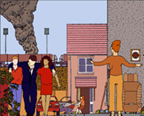
Creating Utopia
spring_alpha is a networked game system based on Chad McCail's drawing "Spring" and the series "Evolution is Not Over Yet". This narrates the attempts of a small, urban community to create its own "utopian" society. The narrative is used as a metaphor for the real-world issues that the project explores and a focus around which speculative and critical ideas can develop. The software system serves as a "sketch pad" for testing out ideas for alternative forms of social practice at both the "narrative" level, in terms of the game story, and at a "code" level, in terms of working with the actual data and communication structures that support the game. It is an exploration of software and social governance in relation to Free Open Source Software practice. The project combines the development of an open software system along with workshop events that seek to broaden Free Open Source Software development principles into areas outside of programming. [via Rhizome]
The spring_alpha game takes place inside a simulated world that is based on that in Chad's drawings but expanded by the players. The original stories and images become a framework that is fleshed-out by people's own ideas and experiences.
The basic aim of the game is to change the rules by which the society in that world runs. This is done through hacking and altering the code that simulates that world, creating new types of behaviour and social interaction. How effective this becomes depends on the players' ability to spread these new ideas into the society.
The project is being realised through a series of development modules. Each module is a self-contained smaller project that focuses on specific development issues such as research, software creation, and public participation. In module 1, for example, a prototype version of the game was built. Other modules focus on working with local communities to develop game characters and scenarios reflecting their own responses to the ideas of the narrative.
The project provides free access to the code and tools being developed through it. We are also providing documentation of how the project is being realised as it progresses. We are testing out and demonstrating new ideas about what a game can be, how it gets made, and what gameplay can involve.
This site provides copies of the original story and drawings, documentation of the modules, software downloads and information for developers.
Posted by jo at 10:46 AM | Comments (0)
CAPTURE THE FLAG ! DUMBO, Brooklyn
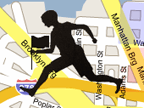
Totally Regressive Team Game
Join us for Capture the Flag (tonight), the totally regressive team game with bases, jails, sides and flags! Run beneath the bridges of Brooklyn's waterfront, treading over cobblestones and trolley tracks. Outwit opponents, hiding around warehouse corners before you find their flag, outmaneuver their flag keepers and dash home for a point in the pulse-quickening game of urban capture. efend your territory with its view of the Manhattan skyline by tagging trespassers.
These games have been wonderful; come capture the flag for a night of summer joy. The streets are your playground, reclaim them! Rain or shine, play at your own risk! Jay St. & York St. // 8:00 PM, DUMBO, BROOKLYN (F to York). Future games: If you want to host future games, e-mail kevin[at]newmindspace.com.
Posted by jo at 10:13 AM | Comments (0)
Narrative Across Media: The Languages of Storytelling

Will New Media Produce New Narratives?
"...The book's fifth and final section, "Digital Media," is certainly the most pertinent, at least to cyberculture scholars. In order to answer her question, "Will New Media Produce New Narratives?" editor Marie-Laure Ryan explains that, from her perspective as narrative theorist, three issues must be covered. Firstly, Ryan must define narrative. For her, a definition of narrative must be "sufficiently abstract . . . but flexible enough to tolerate a wide range of variations" (337). Thus, "narrative is a mental representation of causally connected states and events that captures a segment in the history of a world and of its members" (337). Secondly, Ryan pinpoints several properties of digital media which "affect narrativity in either a positive of a negative way" (338). Some examples of the "fundamental" properties are: "reactive and interactive nature;" "multiple sensory and semiotic channels;" "networking capabilities;" "flui[d] and dynamic nature;" and, finally, the ability for digital works to "undergo various transformations" (338). The third issue involves a more precise definition of the term "interactivity." According to Ryan, interactivity, i.e. "user participation" (339), is based on two dichotomies: "internal/external involvement" and "exploratory/ontological involvement" (339)..." From the review of Narrative Across Media: The Languages of Storytelling by Jessica M. Laccetti, Resource Center for Cyberculture Studies.
Editor: Marie-Laure Ryan
Publisher: Lincoln, NE: University of Nebraska Press, 2004
Review Published: June 2005
Posted by jo at 09:59 AM | Comments (0)
June 21, 2005
Ctrl-C Ctrl-C
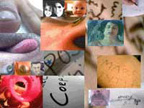
De-Territorialized Bodies
Ctrl-C Ctrl- C, by Corpos Informaticos, is a telepresence performance that explores the possibility of poetic interaction in a telematic environment, the notion of the absent body which participates in an affective aesthetic experience, using the Internet as a space of realization and the public [on-line and live] as co-authors of the work.
Telepresence performance takes place on the World Wide Web. It involves de-territorialized bodies, reorganized [re-orphans] in monitors that are dispersed in the world. The Internet, a net of communication, is in fact a net of information. In telepresence performances, subjectivities are connected in real time, in direct communication; interlocution. The concept of Performance Art widens itself: an ephemeral and presence-oriented art, can it be virtual? How much [or how much longer] is the spectral body able to arouse emotion, affection? What is the concept of "group" for the one who extends oneself and becomes part of the Internet community? The collective work that requires such openness of its members is now open to numerous, infinite participants with different perceptions of interlocution. This communication, a truthful sharing, is it only an idea of encounter? For Performance Art in telepresence, is it an opening for the body to became spectral? Or is it just submission to the demands of the machine?
Posted by jo at 10:32 AM | Comments (0)
Civic Maps
A Mapping Module for Civicspace and Drupal
Here is a first pass functional mapping module for civicspace and drupal as demonstrated here: http://civicmaps.org/?q=2005_06_20_Scappoose_Events
Essentially if you were to install drupal and civicspace you could have a location blogging site up and running quite easily now. Are there any other such services in the world at all right now? I don't think so; so I do believe (at least from our limited perspective) that this is something that may be genuinely useful. Here is the site for the download: http://maps.civicactions.net#download
This is hot off the presses and undoubtably there are defects. However it is a milestone in our development work here and as is often said 'publish early and publish often'. Having reached this milestone I wanted to briefly summarize what the deeper purpose of this was since it is not documented on the site:
* Civicactions, (Anselm Hook) and quite a few others are continuing to look for ways to help energize real world community not just virtual community. The challenge is that a lot of our urban landscapes are somewhat mechanized. They've scaled up to industrial proportions but we have not equivalently developed an industrial scale voice. Although possibly a romantic view, there is the feeling that in earlier and smaller communities it was much easier to inadvertently be a part of the social knowledge commons of that community. The hope here is that rich client side mapping tools that are dispersed over many many servers (instead of centralized) will help create a more true, richer and authentic voice than what we get from the commercial mapping sites.
* This work although free is actually quite expensive. It is time consuming and labourious to develop for very little financial gain. At the same time if somehow services like this could 'raise all ships' then perhaps we might not have quite so much a need for money in our society. Money is a substitute for awareness. As local currencies show one undervalued function of money is as a discovery tool or a catalyst. If I were better connected to my own physical neighbourhood I might be able to message all my neighbours asking who could lend me a ladder, or a boat or some such thing - rather than purchasing one or renting one. Or equivalently I might have a lot of free time on my hands and could volunteer for some fun local neighborhood project if only my peers knew I was interested. For many people, especially in mobile urban societies, it is hard to have that kind of groundedness and trust. Tools that accelerate that process, that show us our landscape, our peers, where our friends are or have been, the knowledge that they shared... well these are all ideas that are out there and have been discussed quite a bit - but it still doesn't feel as if they have really been exercised. So this is more of the same in a sense; continuing to try to push out tools that help get computers to come out and play with us, and help us in the real world, instead of sucking us into a virtual contextually disjointed reality. If 80 percent of human discusion involves space and location then 80 percent of our tools should support this.
We definitely appreciate feedback and even flames - post your thoughts on the http://civicmaps.org site. This process is driven by user feedback and interest. Continually in open source development one is trying to pick the absolute best project and absolute best use of time that one can possibly pursue. Feedback on this particular project will dictate if it gets more attention and time.
Anselm Hook [originally posted to locative]
Posted by jo at 09:07 AM | Comments (0)
Sale Away
![saleaway_11[1].jpg](http://www.turbulence.org/blog/images/saleaway_11[1].jpg)
Mechanical Orchestra with you as Conductor
In Sale Away, passers-by can conduct an "orchestra" of household devices via their mobile phones on a display window. The mechanical orchestra consists of flute, organ and brass playing vacuum cleaners, rattling kitchen mixers, buzzing ventilators, radio playing toy trains, wobbling jigsaws, dancing tumble dryers, humming refrigerators and other misused household utilities.
The conductor is a big refrigerator. This fridge is also the explanatory interface. To start the orchestra and wake up the shopping windows you have to dial the number and follow the commands displayed on the window. This call opens the door of the fridge, giving free the image of its explanatory interface, the "mobile phone robot person". The robot will explain and invite you to act. By pressing keys on the phone you can let all different instruments play along with the melody. You can set some single voices or the whole orchestra tutti.
Video. By Geert-Jan Hobijn (NL) and Carsten Stabenow (GER) Olaf Matthes (GER) from Staalplaat. Via the excellent Culture Base Open List. [blogged by Regine on near near future]
Posted by jo at 08:59 AM | Comments (0)
Rixome
![madrix_final_b[1].jpg](http://www.turbulence.org/blog/images/madrix_final_b[1].jpg)
Become a Walker
rixome is a network and a tool that turns mobile screens into windows that show the virtual and public dimensions of our point of view. A walker (a rixome user) can see on his/her mobile phone/PDA/laptop screen the virtual interventions that have been added to the location where s/he now stands. For example, a spoken message can be left on a given location for other "walkers" to hear through headphones whenever they pass by. The message can also be written, or it can be a 3D animation or image, a photography, a drawing, a video.
Remote rixome users can also check vía Internet the traces left by others but s/he won't be able to add an intervention similar to those published in situ. Developed by gelo for his at Master of Art and New Technologlies at the Universidad Europea de Madrid. [blogge by Regine on near near future]
Posted by jo at 08:54 AM | Comments (0)
June 20, 2005
Invisible Media
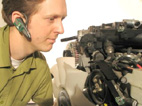
Sensing Focus
Invisible Media: David Merrill and Daniel Schultz are investigating the interaction possibilities that arise when objects in the environment and wearable computers can cooperatively sense the focus of a person's attention. Currently implemented with infrared transceivers, Invisible Media can sense the gaze of the user, while simultaneously communicating their identity. In a learning scenario this two-way ID passing and attention sensing can enable a stateful teaching interaction that tracks the progress of the learner. In a public setting, objects being attended to can transmit the URL of a relevant audio stream or other media to a mobile user. Exciting opportunities for collaborative filtering arise when the number of users and augmented objects gets large.
Posted by jo at 11:07 AM | Comments (0)
4d Pixel
![]()
Direct Human Intervention in Architecture
4d Pixel--by Daan Roosegaarde--is a smart surface which physically reacts to your voice, music and can write relievo letters. The dynamics of the moving wall obeys human interaction, magnet-technology and intelligent software. 4d pixel is about how to create a direct human intervention in architecture, not about electronic circuits or mechanisms... how can space be adaptive to the needs of its users.
4d pixel is being developed as a large façade for a public building and is currently shown at Berlage Institutein Rotterdam, the Netherlands. Related: Reciprocal Space. [blogged by Regine on near near future]
Posted by jo at 10:39 AM | Comments (0)
Squidball

Large-Scale, Real-Time Motion Capture
Squidball is a large-scale, real-time interactive video game that uses motion capture technology to create a unique and energetic gaming experience. In the world’s largest calibrated motion capture volume, the game debuted on August 12th, 2004, with an audience of 4,000 people, at the Los Angeles Convention Center, as pre-show entertainment for the SIGGRAPH Electronic Theater. SIGGRAPH is the Association of Computing Machinery’s Special Interest Group in Graphics.
Squidball is played with several (12 at SIGGRAPH) large (approx. 4ft in diameter), helium-filled weather balloons in retroreflective jackets – these are the input devices for the game. By throwing, batting and bouncing the balloons throughout the playing field (which, in this case, was approximately 400x200x40 cubic ft), the audience plays to eliminate the on-screen targets, which are represented on a giant 40-foot video screen that also displays scoring and timers. As a result of this unusual motion capture application, the audience sees the balloons move across the two-dimensional video projection screen as they simultaneously interact with them in the 3-D space. Winning the game inspires and requires collective cooperation among the entire audience.
Posted by jo at 10:27 AM | Comments (0)
I Connect Therefore I Am:
![]()
Connectivity and Networking
"The notion of connection refers to both metaphorical and material practices informing our understandings of the flows of energy and information within human bodies, communities, geographies, and technological networks. Cranny-Francis offers a definition of connection which accounts for the term's significance in the contexts of both Cultural Studies and multimedia literacy:
It refers to the ways in which texts generate meanings through their relationship with other texts, to the development of multimedia technologies that are characterized by their connectivity (the web, the net), and to the ways in which meanings are generated crucially by the connection between texts and their users. (Cranny-Francis, forthcoming)" From I Connect Therefore I Am: Connectivity and Networking in Bodies, Technologies, Communities, and Selves by Anthony Lambert [via]
Posted by jo at 10:03 AM | Comments (0)
Sound Lines

Captured Layers of Energy
Using live audio feeds from Leeds City Station and the River Aire, US artist Bill Fontana will craft a giant sculpture of sound turning the historic Dark Arches into an immense musical instrument. For two months a loudspeaker system installed within the arches will fill the space with an ever changing combination of live sounds relayed directly from specialist listening devices installed in the surrounding area.
A series of microphones high up in the structure of the station will pick up the bustle of platform activity, whilst sensors fixed directly onto the track buffers will listen to the distant vibrations of incoming trains as they approach, slow down, and come to a stop. Beneath the station, underwater microphones will be plunged deep into the course of the River Aire as the flow of water is redirected through the arches. Sound Lines attempts to capture these continually changing layers of energy as they arrive, depart, and flow through the city.
San Francisco based Bill Fontana is known internationally for his experimental work with sound. Using urban and natural environments as a living source of musical information he radically transforms the meaning of public space. His extensive body of work includes temporary and permanent installations in New York, Paris, Vienna and London. (resoundings.org)
Posted by jo at 09:46 AM | Comments (0)
June 17, 2005
The Head

A Wearable Sculpture
The Head is a wearable sculpture with a connection to the internet and a public access via sms. The sculpture contains "an eye" (a camera lens) and a camera phone which captures images and sounds in certain intervals. People can send the Head sculpture an SMS to which the sculpture responds by capturing an image and recording a short soundfile. This image and the sound are sent back to the SMS-sender. They are also uploaded to a website with date and time of the capture accompanied with the sent sms-message.
The Head will be adopted and carried around by people and its "vision and hearing" is both automated and triggered by public to collect memories on the way. It will be also set (by the artist) to be adopted by people in professions which generally have "a view" on the society: police officer, politician, tourist guide, teacher, etc. Author: Laura Beloff (one of the developers of the Seven Mile Boots.) [blogged by Regine on near near future]
Posted by jo at 10:01 AM | Comments (0)
Anne Galloway

Inscription, Enrolment and Agency
"The state is going to be recording everything we do, why shouldn't we make our own recordings -- if only to challenge the accuracy of what others capture?"
In Inscription: Surveillance Turned Inside Out, Howard Rheingold talks to Microsoft sociologist Marc Smith about "ways to use tomorrow's panoptic snooping technologies".
I was instantly struck by Smith's use of the term "inscription" - instead of "authoring" and despite AURA's call to "annotate the planet" - a term which Rheingold describes as relating "to behavior that leaves traces detectable by others." But because words do things, because speech acts, inscription also means enrolment** in particular contexts, identities and practices.
The current obsession with tagging and projects like Urban Tapestries, Yellow Arrow, Grafedia, MapHub (and, oh, about a million others now) all work off the general idea that "regular" people can, and indeed should, declare and order their experiences and ideas, and share them with other people.
I don't know where or when "bottom-up" became an absolute social, cultural and (cough) ethical good, but classification, authorship and/or publication are not simply matters of production, or more specifically, about changing the means of production. First of all is that pesky matter of consumption and use: how are people actually consuming and using this information? Second, into which (unequal) arrangements or assemblages do all these practices enrol us?
For example, do we really want to say that when Microsoft or Nokia record everything that it is inherently better than when The State does it? What kind of agency do we actually have? When we use our blogs for 'impression management' or when we post pictures of ourselves to Flickr to have more control over what appears in searches, what kind of agency is that?
** In the work of Michel Callon and Bruno Latour, enrolment refers to the "process in network-building in which actors' support is gained for development of a sociotechnical entity, their role defined and their interests and identities orientated to suit." In other words, an actor/actant must be made relevant to others (interessement), be made indispensable to others (translation), and be granted consent by others (enrolment). [blogged by Anne on purse lips square jaw] [Readers' comments]
Posted by jo at 09:26 AM | Comments (0)
Internet Theatre Fest
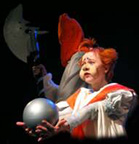
Cross-Cultural Artistic Expression
Last October, Moscow’s Interstudio presented the First Interactive Theatre Festival. Seven Russian companies – performing in four locations and a variety of theatrical traditions – participated in this groundbreaking event. Productions were streamed live from Moscow, Perm, St. Petersburg, and Komsomolsk-na-Amure to the Interstudio site, and viewed by over 2000 users from more than fifty countries.
Featured in the festival were: Pyotr Fomenko Atelier (Moscow) performing THE FAMILY BLISS, The Shadow Theatre (Moscow) performing MISANTHROPE / RAIN AFTER THE FLOOD, Elena Kamburova Music and Poetry Theatre (Moscow) performing P. S. REVERIES..., Evgeny Panfilov Ballet (Perm) performing EIGHT RUSSIAN SONGS / BOLERO, Helicon Opera (Moscow) performing LULU, KnAM Theatre (Komsomolsk-na-Amure) performing REINSTATEMENT OF DADAISM, and The Comic Trust (St. Petersburg) performing THE WHITE SIDE STORY.
Following the final production of WHITE SIDE STORY, audience members from Moscow, St. Petersburg, and New York participated in a discussion forum conducted via web conference. Participants shared their visions for cross-cultural artistic expression, and their hopes for future streamed performance festivals. Though this fledgling effort weathered many technical difficulties, viewers voiced enthusiastic agreement about its tremendous potential.
The festival organizers had tried to anticipate bandwidth problems by asking viewers to register in advance, but on the first day of the festival, the website was swamped, and finally overwhelmed by high demand.
Viewers were offered a choice of three video streams, one with sound, which could also be viewed simultaneously. Audience members in New York, watching a wall-sized projected image, had a detailed view of the performances, although some viewers were distracted by the lack of synchronicity between the three video streams. Some audience members also expressed their desire for a view of the live audience, and a look at the theater space – two things that might have helped them get a feel for the live performance experience.
At the same time, New York viewers were excited by the unique opportunity to experience an unfamiliar theatrical style. Most felt they understood the Russian shows -in spite of the language barrier and technological limitations - and talked about how the Russian work could influence their own artistic work.
The Russian performers also seemed excited by the new possibilities explored in the festival. One company – from a small Russian town – had never dreamed they would be able to reach such a large international audience. Directors and performers had many ideas about ways to improve the web-streamed experience, including rehearsing camera operators and designing staging for the camera as well as the live audience.
Theatre-Web hopes to put these ideas into practice in future festivals. [via Digital Performance]
Posted by jo at 08:16 AM | Comments (0)
June 16, 2005
Contemporary Art Month
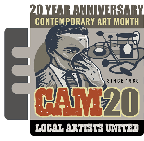
Call for Submissions: Networked Performances
CAM San Antonio (Contemporary Art Month) is currently accepting submissions for networked performances in July. Events would be included on our online calendar and promoted in print and via local radio. We currently have two virtual events scheduled--one will be at the Lab Gallery in NYC, the other is local.
If you have anything going on or know of anyone who does, please pass this communication along. If you'd like more info on CAM, check out our press page and history.
Posted by jo at 02:28 PM | Comments (0)
Human Browser
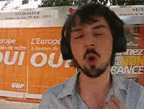
Helping France Vote
Paris, Sunday, May 29, 2005 : Jérôme Piques v1.0, the first Human Browser, created by net artist Christophe Bruno, experimented nearby a Parisian polling station. "This piece is a wireless Google hack: as I enter keywords in a Wi-Fi pda, to briefly describe the actor’s context, a program on a laptop uses these keywords as search strings in google. Then the laptop sends a text-to-speech audio of the search to an actor who then repeats what he’s getting via the headphones."
As a new epidemic of Turing Syndrom is spreading in France, unable to decide its own future, The Human Browser offered to help the nation. During a few hours, thanks to its brand new Wi-Fi connection and its amazing ability of real-time Web-mining, The Human Browser tried to invest in language derivative by-products, in a deflationary global semantic market. [blogged by Murphy at post.thing.net]
Posted by jo at 11:18 AM | Comments (0)
Hundekopf
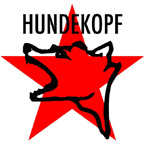
Interactive SMS-story around the Ringbahn
"Stories (...) are like mountain tops jutting out of the sea. Self-contained islands though they may seem, they are upthrusts of an underlying geography that is at once local and, for all that, a part of a universal pattern." - Jerome Bruner, Acts of Meaning (1990)
Hundekopf--by Knifeandfork--is a new project exploring the experience of Berlin's Ringbahn, which encircles the inner city and is used as a literal vehicle to move between time and place in a fiction-historical narrative structured through SMS text-messaging. The Knifeandfork artist group approaches the urban environment as a narrative space - a human artifact constructed of stories both real and imagined that we collectively engage in telling. Hundekopf is being performed at Loving Berlin, June 20-25, 2005.
Posted by jo at 10:47 AM | Comments (0)
BUMP_NET - 2005
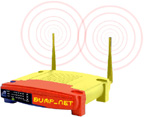
A Wireless Network for the Determined
BumpNet--by Jonah Brucker-Cohen--is a wireless network that challenges the existing methods of connectivity among multiple clients to one wireless base station. The project consists of a public wireless network that only supports a maximum number of connected clients. When a new person joins the network, the first person on the queue is "bumped" or dissallowed access to the connection and network. Like its predecessor: BumpList (an email community built around the same principles), the focus of the project is to determine if by attaching simple rules to communication infrastructures, the method and manner of connectivity and behaviors of people connecting will change over time.
Posted by jo at 10:33 AM | Comments (0)
Janet Cardiff
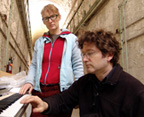
Invisible Architectures
"For the second consecutive summer, Janet Cardiff’s celebrated audio tour Her Long Black Hair is being presented by the Public Art Fund in Central Park. But this isn’t Cardiff’s only summer engagement on the East Coast. The percussive sound installation Pandemonium, made collaboratively with her partner George Bures Miller, is at the Eastern State Penitentiary in Philadelphia until November 1. Here, art critic and historian Megan Heuer discusses Cardiff’s use of sound to examine the phenomenology of social settings.
Since the 1980s, Janet Cardiff has made art that employs sound as a physical material. In the elaborate installation The Dark Pool, (1995) sounds are located within an enigmatic, cluttered study and shift according to where one stands. Her binaural audio walks use her own recorded whispering to direct the participant’s movement through a landscape. Much of Cardiff’s work explores the nature of subjectivity within the highly mediated universe of contemporary culture, questioning the boundaries between fact and fiction, reality and memory or fantasy..." Continue reading Invisible Architectures by Megan Heuer, NYFA Current.
Posted by jo at 07:44 AM | Comments (0)
June 15, 2005
MapHub
![]()
Shared Urban Storytelling
Another urban mobile project in the lines of Yellow Arrow and Grafedia, called MapHub, located in Pittsburgh, PA. It's about shared urban storytelling and enables residents to for search and publish information about their city. In their own words: Create a sonic landscape of Pittsburgh by calling in cellphone recordings from around the city. Sounds from the Heard Hub launched February 1st will be on displays in Karsruhe, Germany, at the Center for Arts and Media through August 2005.
To participate, all you have to do is create a profile then search for users or Hubs in your city. Create your own Hub to publish location based information. There is a second project, HeardHub2, made possible by the MapHub web application. For HeardHub2, three performers will reconstruct soundscape elements into a composition in real time, from sounds recorded to the HeardHub database using mobile devices. Audience members, friends, and people walking by will be able to call a number from their cell phone to record sounds from anywhere in the city. [blogged by Emily on textually.org]
Posted by jo at 11:22 AM | Comments (0)
Gaming Mind, Gaming Bodies:
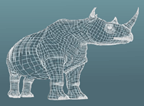
Mind-Body Split For the New Millenium
"Abstract: The role of the body while playing a First-Person Shooter (FPS) may seem simplistic at first glance. We are sitting in front of the computer or TV and playing a game. However, the fact that we, as players, have another body within the game complicates this. Further complicating things is the fact that, like our bodies in the physical world, in a FPS we rarely see our virtual bodies. Therefore, the seemingly simple question of “Where is the body when we play a FPS?” in not one that can easily be answered. Unlike some types of videogames, such as older games like Pac-Man or Dig Dug, that only allow the player to move in specific directions such as up, down, left or right, in a FPS, the player, as in real life, is not confined to predetermined, limited set of movements but can turn, weave, walk in one direction while looking in another and so on.
Because the movements aim to replicate those of an able-bodied person, what happens while a person plays the game is that once the control system has been mastered, one tends to forget that they are controlling another body at all and become sutured into the world of the game. Essentially, when the game is going well, we as players have two bodies, one inside the game, and one outside.
Many scholars have argued that the dream of cyberspace is to leave the body behind and become pure thought. It is true that while playing a First-Person Shooter, the physical body is made absent. When I play one of these games, my own body is not what I am concentrating on. While playing I may physically sit in a chair, typically, I am not conscious of that sitting, nor am I aware of what my legs or feet are doing. This is why while playing a FPS, the physical body recedes away.
However, far from being a dream of disembodiment, FPS games are masculine embodiment writ large in which the entire point is the body. As depicted within the games, players are nearly always overly muscled, heavily armored men with hugely phallic weaponry. While it may be true that FPS games are all about the body, in a FPS, things are not as simple as they appear because the nature of a FPS, in which players see through the eyes of the body within the game, causes a further erasure to occur.
It seems that while playing a FPS game, not only is the player’s attention not dwelling on one’s embodiment, there seems to be another type of embodiment that is going ignored. Because players see though the eyes of the character, we do not see the that characters body and, for all intents and purposes, the player is the character. While it may seem that this is simply inserting the body into a virtual world, it does not do this at all. It creates a second body, which the action and pace of the game then serves to render invisible. At least for the experienced player, while the physical body is not the object of experience, neither is the virtual body. Thus, it seems that in a FPS, not only is a player not aware of one’s embodiment, they are similarly unaware of their disembodiment. In this way, it not only mirrors the invisibility of the physical body but also serves as a naturalization of that invisibility. The game causes us to forget about both bodies but still behave as if we were the hyper-masculine ideal. Thus, players are leaving behind the body, but taking the “meat” of the body with them. In this way, it seems that playing a First-Person Shooter is a way for society to further render the body invisible.
Drawing on Randy Martin’s Performance as Political Act and Drew Leder’s The Absent Body as tools to help understand both the disappearance of the body as well as the ways in which our body appears – or dys-appears, to use Leder’s terminology – when we stumble or are in physical pain, I argue that in some ways playing a First-Person Shooter is an attempt to gain a virtual form of embodiment in a type of body that society deems as the ultimate in masculinity. This attempt is less than successful, however, due to the very nature of the physical body in that it typically goes ignored unless something is wrong with it. In this way playing a First-Person Shooter causes the Cartesian mind/body split to be made literal with the mind in the physical world, a the body in the virtual world and a physical body that is nowhere to be found.
As noted, Drew Leder calls the negative appearance of the body that happens in situations such as when our bodies hurt or we trip a dys-appearance. Building on this, I call what occurs when a player becomes aware of their disembodiment as in a situation when a player’s fingers hit the wrong key or encounters a bug in a game, a dys-embodiment. These dys-embodiments call attention to the bodies of the game and the fact that while playing a FPS, the body within the game is not the same as the body outside of the game.
In this paper, I will show that questions such as, “What is the role of the body while playing videogames?” or “Where is the body located? Is it sitting in a chair in front of the monitor, or is it in the game running and shooting?” are not easy to answer. By problematizing our conception of the body and exploring the ways in which First-Person Shooters complicate notions of embodiment and disembodiment, I will show the form of the games themselves can have just as large a role in influencing our conception of self as the content of the games. “There is more than meets the eye” is not just a saying when it comes to First-Person Shooters." From Gaming Mind, Gaming Bodies: Mind-Body Split For the New Millenium (.doc) by Bryan-Mitchell Young, DiGRA Conference proceedings.
Posted by jo at 10:53 AM | Comments (0)
Machinima:
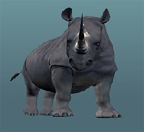
Digital Performance and Emergent Authorship
"Abstract: This workshop investigates the emergent online dramatic form of "machinima", the co-option of video game engines or off-the-shelf software for dramatic production in a rapidly developing digital performance form. Workshop participants will engage with short examples of popular machinima productions. There will be discussion and demonstration of the machinima production process. The nexus between dramatic conventions, gameplay and traditional video production techniques will be explored. Participants will work with a short piece of a machinima, in the form of a scene created using the Sims 2 game. Participants will improvise, script and perform dialogue to provide meaning for the action. This workshop applies the insights of process drama, a field well developed in educational settings, to the development of machinima. It includes demonstration and participation in dramatic role, focusing on how the conventions of Role Distance and Role Protection apply to this developing field of digital game-based performance." From Machinima: Digital Performance and Emergent Authorship (.doc) by John Carroll and David Cameron, DiGRA Conference proceedings.
Posted by jo at 10:25 AM | Comments (0)
June 14, 2005
Living Book of the Senses

Body Stories
In Living Book of the Senses--by Diane Gromala--users are able to see their physical surroundings while dynamically engaging with three-dimensional mixed realities which appear on their headsets. Users can interact with the book in dynamic ways. They can ask the book questions (via voice recognition), and can influence the book through their sensory (bio) feedback. Users wear a headset/head-tracker/color camera system that enables them to see physical reality enhanced with a virtual reality overlay. The camera inputs images/patterns and feeds them back into the ARToolkit software which then displays digital information associated with the physical markers onto the headset. The ARToolkit can calculate camera position and orientation relative to physical markers in real time for video-mediated reality.
Each reader can view AR scenes from their own visual perspective. Users can fly into the immersive world and see each other represented as avatars in the same virtual scene. Readers remaining in the AR scene have a birds'-eye view of other readers as miniature avatars in the virtual scene displayed through their headset. User-controlled dialog with the book elicits responses/answers from the book (expressed in digital data: visual, textual, auditory). As the users simultaneously interact with the book in the physical and virtual realms, the book responds to individual and multiple physical states (via biofeedback) to express resulting changes in narrative. The narrative is a cultural history of the senses. [Read Extensive Bodies, interview by Yvonne Volkart with media artist and theorist Jill Scott].
Posted by jo at 09:00 AM | Comments (0)
Review of "A Walk to Remember"
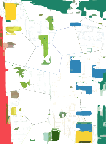
Art on the Outside
Review of A Walk to Remember, Los Angeles Contemporary Exhibitions, February 9 - May 8 2005; Organized by Jens Hoffman, Director of Exhibitions, ICA, London.
The concept of "walking" in the city of Los Angeles conjures up all kinds of cliches and jokes about how "no one walks in LA," and the amorphous qualities so often ascribed to its social and natural geography. Such an impression is easily adopted, as typically one moves by car from one part of town to another, only getting out upon reaching desired destinations or to refuel at gas stations. The language used to describe LA's paved circulatory system belies the indifference to the space that lies between points A and B. On the one hand, there is the web of interconnected freeways that allow one to move from destination to destination, as if in some kind of congested time-space portal, and on the other are the "surface streets," existing at ground level, where daily life plays out.
This February, Los Angeles Contemporary Exhibitions provided access to this surface world through a series of artist-led walks curated by Jens Hoffman of the Institute of Contemporary Arts in London. Titled "A Walk to Remember," the exhibition brings together walks by LA-based artists John Baldassari, Jennifer Bornstein, Meg Cranston, Morgan Fisher, Evan Holloway, Paul McCarthy, Rubén Ortiz Torres, Allen Ruppersberg and Eric Welsey. Participants on each of the walks will be given a disposable camera with which to document the event, with the results being displayed in LACE's exhibition space.
Of course, walking already has established historical ties to performative and conceptual art practices. Richard Long and Andy Goldsworthy's formal traversals into the non-urban, the illegal border crossings of Christian Philipp Müller and Heath Bunting, and the urban derivés of the Situationists are but a few examples of the aestheticization of bipedal transportation. The LA Times recently celebrated LA's own amateur walkabout, an engineer named Neil Hopper, who documents his extensive hikes around the city on walkinginla.com.
The descriptions of the walks hosted by LACE range from a leisurely walk below the Hollywood sign in Griffith Park (Bornstein and Wesley) to a trip to Sherman Indian High School, one of three remaining off-reservation Native American boarding schools in the country (Cranston). Fisher and Ruppersberg set out to explore the intersections of personal and collective memory in the ever changing urban landscapes of Santa Monica and Hollywood, respectively. There are also "instruction" pieces, where walkers are asked to either photograph all the street signs from Baldassari's studio or perform their own walk ten consecutive times, per McCarthy¹s request.
By the time of this writing, this writer was able to attend the first two walks - Ortiz Torres' trip to El Pedorrero ("the farter"), a muffler shop and museum in East LA, and Holloway's walk from his studio near MacArthur Park. The tour of El Pedorrero, an ultra baroque environment shaped by the imagination and efforts of its owner, known as "Bill Al Capone," revealed an aesthetic vision of the "American Dream" that recombines both the utopian and vulgar aspects of modernity into one seamless architectural space. Holloway's walk from his studio to the Alvarado/7th St Metro Station, in an area known for gang activity and the infamous LAPD Rampart Division scandal, is the only walk that explicitly offers danger as bait to participants. The artist even pointed out the location where he was mugged almost three years before.
Art that involves any sort of interaction with a community, outside of its own, has been the subject of a fair amount of criticism from wildly different perspectives. "A Walk to Remember" may not situate itself as a form of "community art," but it certainly shares more than a few concerns and formal strategies. It may be worthwhile, then, to reexamine Hal Foster's critique of the ethnographic urge found in some site-specific art of the previous decade. The slippages Foster found between artists' identifications with an "outside" and the ability of institutions to assimilate those identities seem an appropriate area of inquiry for current work also dealing with an "outside." In presenting this exhibit, LACE painted one of their rooms to resemble a blank landscape - the walls split by a horizon line separating blue and green fields - which are decorated with maps of the artists' walks and photos documenting them. Perhaps, the artist-as-ethnographer is not the model found here, as any specific identities play only a secondary role. Like much current site-specific art, emphasis is placed on spatial understandings of history and urban geography - with maps being the formal device of the day. The concerns of urban planning and real estate seem to have replaced those of anthropology, as we've learned that identities are only as valuable as the land they occupy.
- Ryan Griffis [for Rhizome]
Posted by jo at 08:16 AM | Comments (0)
Reciprocal Space
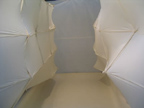
Performed, Experienced, and Felt by Both Sides
Ruairi Glynn has built Reciprocal Space, a physical space that responds to the actions of its inhabitants. The two "Hypersurface" latex walls running in parallel come to life once inhabited, forcing the people to respond and reassess their preconceived ideas of architectural space being fixed.
32 pistons, controlled by a software modify the walls movement according to the visitors' positions. The work will be shown at Submerge, 29th June - 1st July, Bristol UK. Video. [blogged by Regine on near near future]
Posted by jo at 07:53 AM | Comments (0)
The Social Fabric
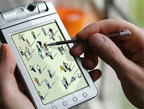
Your Social World
The Social Fabric, by Steven Blyth, is a representation of your social world, displayed as a single visual array on your mobile phone. It keeps you informed about which relationships are prospering, which you have neglected, and the overall state of your social fabric.
A series of avatars on your phone screen represent your friends, acquaintances or relatives. The frequency of all digital communications (they can include voice calls, voice Messages, SMS, MMS, e-mail, Instant Messaging, VoIP, etc.) between you and each person, which the system monitors, determines that avatar's posture: an alert stance indicates frequent recent contact, for example; a lethargic posture or turned back means neglect. You can also register non-digital contacts manually.
The avatars can be grouped manually according to sentiment, category, and so on, or programmed to begin clustering together before an upcoming event: your family before a birthday, or friends before a poker night, for example. Related: Gori. node garden. [blogged by Regine on near near future]
Posted by jo at 07:48 AM | Comments (0)
Storytelling Wearables: An Alternative Autobiography

Mobile Biography
Xiao Li Tan's Storytelling Wearables: An Alternative Autobiography explore storytelling and enable people to discover Xiao's relatives and birth city through looking at the movie bag, examining the shell necklace, and by lifting the hidden pieces on the skirt. The Portable Movie Bag shows images of Taishan in China. People can also learn about the stories of the artist's relatives by lifting some fabric on the Peekaboo Portrait Skirt, and they can experience her childhood memory of shells through the glowing Mood Shell Necklace. All the pieces are either powered by 3v battery, or self charged battery. They are portable and meant to be worn. More pictures. [blogged by Regine on near near future]
Posted by jo at 07:44 AM | Comments (0)
June 13, 2005
Social Tapestries
![]()
Public Forum, 1st July 2005
Proboscis will be holding a half-day public forum on the Social Tapestries research programme hosted at the Stanhope Centre for Communications Policy Research on Friday July 1st 2005 1-6pm. The event will bring together practitioners from the arts, industry, government, civil society organisations and academia to review the work underway for Social Tapestries and stimulate public debate on the issues.
This event is a pre-competitive forum for the free exchange and flow of ideas intended to generate opportunities for dynamic partnerships that find common ground between artists, culture organisations, civil society organisations, academia, government and public agencies, business and industry. To book a place please complete the online form. Places are limited to maximum of 70. [blogged by on giles on urban tapestries]
Posted by jo at 10:34 AM | Comments (0)
Indeterminacy

A young man in Japan arranged his circumstances...
John Cage was an American composer, Zen buddhist, and mushroom eater. He was also a writer: this site is about his paragraph-long stories -- anecdotes, thoughts, and jokes. As a lecture, or as an accompaniment to a Merce Cunningham dance, he would read them aloud, speaking quickly or slowly as the stories required so that one story was read per minute. Indeterminacy archives 186 of those stories. Each story is spaced out, as if it were being read aloud, to fill a fixed area. If you like, you can also read them aloud at a rate of one a minute. The stories are taken from two of Cage’s books, Silence and A Year from Monday, and from the Folkways recording of him reading 90 of them aloud as David Tudor plays piano (among other things).
Posted by jo at 09:57 AM | Comments (0)
GeoSkating
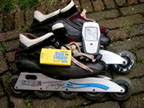
Multimedial Skate-Maps
GeoSkating aims to automate the generation of interactive, multimedial skate-maps by using the Global Positioning System (GPS), Mobile Phones and the Internet. The key idea is that while skating, GPS position data is being assembled and published to a server through a mobile phone. At the same time the skater can enrich the GPS data with road surface ratings and by submitting media items (pictures, videos). The server will draw geographic maps showing road quality through colouring plus the submitted media on the GPS locations where they were captured. In addition, skaters can also be seen moving in real-time on the map while skating!
Posted by jo at 09:44 AM | Comments (0)
INSCAPE
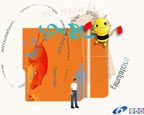
Invitation to join the Open Community
The story is the richest heritage of human civilisation. One can imagine the first stories being told, several thousand centuries ago, by wise old men huddled around campfires. Since this time, the narrative process has been considerably developed and enriched: sounds and music have been added to complement the speech, while scenery and theatrical sets have been recreated to enhance the story environment. Actors, dancers and technicians have replaced the unique storyteller. The story is no longer the sole preserve of oral narrative but can be realised in book, theatrical, dance or movie form. Even the audience can extend up to several million individuals.
And yet in its many forms the story lies at the heart of one of the world's most important industry.
The advent of the digital era has enhanced and accelerated this evolution: image synthesis, digital special effects, new Human-Computer Interfaces and the Internet allow one to not only realise more sophisticated narrative forms but also to create new concepts as video gaming and virtual interactive environments. The art of storytelling is becoming evermore complex. The Information Society Technologies offers new tools to capture, and to interactively modify the imaginary environment, in ever more intuitive ways, coupled with a maximum sensory feedback thus allowing enhanced and exciting production possibilities for the interactive creation and non-linear manipulation of almost any story form.
INSCAPE aims to enable ordinary people to use and master the latest Information Society Technologies for interactively conceiving, authoring, publishing and experiencing interactive stories whatever their form, be it theatre, movie, cartoon, puppet show, video-games, interactive manuals, training simulators, etc. INSCAPE will generate and develop the knowledge in the emerging domain of Interactive Storytelling by researching, implementing, demonstrating and disseminating a complete suite of innovative concepts, tools and working methods tightly integrated in a homogeneous web-based framework and offering a full chain to people with no particular computer skills, from content acquisition and creation, organising, processing, sharing, and using the way of publishing, from creators to “viewers”.
INSCAPE will also address issues such as the acquisition, the creation, the management and the sharing of interactive stories or their real-time multisensorial rendering combined with natural agent behaviours and multimodal interfaces. It will also provide innovative natural interfaces and devices for intuitively creating or living interactive stories within multidimensional, virtual, augmented and mixed realities.
By addressing this domain, INSCAPE goes beyond “standard” content creation research and technology development projects and will address scientific and industrial simulation, training, education, poetry, art emotions, cultural and human context and diversity.
The specification of the project will be driven by an analysis of the needs of real world users participating in the project as partners or involved in the INSCAPE Open Community. Through the lifetime of the projnd-users, including the Open Community, for purposes of validation on real-cases, demonstration and training. Invitation The Consortium wants to make a leap forward in the technologies which support creative interactive storytelling.
We would like to work with you as potential end-user to be one of the first to learn about the results, use and test the developed technologies at early stages and provide feed-back and input in how to optimize for broad use and roll out.
If you want to be part of the INSCAPE Open community by joining the INSCAPE forum and be one of the first users of the INSCAPE software you can register at www.inscapers.com - under open community.
Open Community Questions: ICNM - International Center for New Media
T: +43.662.630 408 /
F: +43.662.630 408-
office@icnm.net -
www.icnm.net
info@inscapers.com
www.inscapers.com
Posted by jo at 09:38 AM | Comments (0)
Luminance
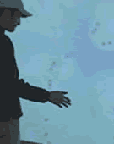
Illusion, Interactivity, and Imagination
Luminance is a live, playful, interactive art installation in which participants use their own physical body movements to create and influence digital content on a 10' X 7.5' screen. Participants are completely untethered. Their gestures, dancing, leaping and stillness can create image elements on the screen that move with the user and/or move digital content already on the screen.
The connection between man and machine has evolved since the invention of the wheel. Our digital age offers increased opportunity to explore the mechanisms by which people in physical realities interact with the world of bits and bytes. These richer, technically sophisticated interactions are gravitating towards humans’ inherently natural movements. With each additional technical innovation, the tethers between man and machine become smaller and less obtrusive, eventually erasing the physical connections altogether. Such innovation allows for creative and artistic exploration as well practical implementation.
A participant in the Luminance installation does not use an input device such as a mouse, keyboard, virtual reality goggles, or any other augmented device. Within the installation space, the user’s image is captured by a video camera. A computer analyzes the user’s image and converts his/her postures into a set of point coordinates.
These coordinates are transmitted to a second computer projecting digital content onto the back of a screen. The point coordinate data from the participant’s movements is used by the second computer to manipulate the projected graphics and sounds. The user plays an integral part in this feedback loop, responding physically to the projections. In some scenes, this movement changes the content and in other scenes it actually creates the content.
Luminance’s technical foundation provides an opportunity to explore the “Three I’s” – Illusion, Interactivity, and Imagination. The illusion of content is combined with interactive movement, providing a multimedia experience which provokes the imagination of Luminance participants, resulting in another level of content. Participation and interactivity are as much a part of the storyline as the visuals projected on the screen and the sound playing in the background. The variety of content provides a number of unique experiences for the participant and increases the potential for inner narrative. [via Rhizome]
Posted by jo at 09:28 AM | Comments (0)
June 10, 2005
A SoaPOPera for Laptops - robotic performance
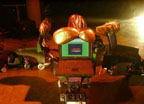
Performing Cars
A SoaPOPera for Laptops consists of four laptops on radio controlled cars. The laptops are mounted on custom made loudspeaker-trailers. The piece uses voice recognition and text-to-speech as well as max programming. The four vehicles are essentially performers. The work involves the four characters talking to each other or singing. Peter Sinclair and G.H. Hovagimyan also perform with the characters, by playing guitar or talking to the characters. A pitch tracking software allows the laptops to listen to a string of notes and sing along. The characters respond to each other via keywords that trigger responses thus affecting natural conversation. The characters cars are controlled by perfomers.
The performances were concieved of as unique and evolutive. The artists created new content and programming structures for each performance. As a consequence there are several difference titles for this performance work denoting the different developments. The alternate titles are: Exercises in Talking and Les Jaseurs. A SoaPOPera for Laptops is in the 2005 Summer Exhibition of the Jeu de Paume museum in Paris.
Posted by jo at 04:54 PM | Comments (0)
GilbertandGrape
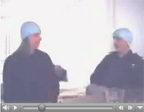
EXTRA: NEWS FLASH ON LIVE REPORTAGE
Steve Kurtz and Steven Barnes were in Stavanger this week to present Critical Art Ensemble. Steve is falsely accused for mail fraud by the FBI and is awaiting a trial. Please reed more about the case and support Kurtz by joining the mail list.
Steve and Steven came along for a ride in the Volvo Amazon with GilbertandGrape, we were planning to do ritual nr 34: Wear a swimming hat whilst making a hubcap think of Esther Williams. The rain was heavy so we skipped the hubcap, went inside to talk about the notions of heroes whilst wearing swimming hats. Watch our live reportage online.
Posted by jo at 03:57 PM | Comments (0)
Yellow Arrow
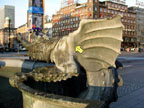
Pointing to the Hidden Stories of the City
"The project Yellow Arrow lets you discover hidden layers of your city and place your own stories in the urban landscape. The project uses text messaging (SMS) as a way to link personal messages to certain locations, which mean something special to someone. You point the attention to the spot by placing a yellow arrow sticker with a unique code, thus making it possible for others to receive the story. Thomas Petersen asked the Yellow Arrow organization a few questions about the project, now that the project is being launched in Denmark. [Get your arrows at the website. Also, sign up for an invitation to the launch party at a secret location, Saturday June 11th at 8 pm!.]" Read interview.
Posted by jo at 08:36 AM | Comments (0)
RealityFlythrough

Harnessing Cameras "In the Wild"
RealityFlythrough is a telepresence/tele-reality system that works in the dynamic, uncalibrated environments typically associated with ubiquitous computing. By opportunistically harnessing networked mobile video cameras, it allows a user to remotely and immersively explore a physical space. Live 2d video feeds are situated in a 3d representation of the world. Rather than try to achieve photorealism at every point in space, we instead focus on providing the user with a sense of how the video streams relate to one another spatially. By providing cues in the form of dynamic transitions, we can approximate photorealistic telepresence while harnessing cameras “in the wild.” [via]
Posted by jo at 08:15 AM | Comments (0)
June 09, 2005
After Land Art:
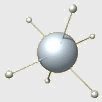
Database and the Locative Turn
"Abstract: This essay asks whether we might learn something from the history of land art that might be important for any re-evaluation of the ontology of art after modernism and conceptualism. It examines the tensions between the 20th century notions of modernism and conceptual art, underscoring their constant interoperation as art system. After exploring the history of database in computation and tracing how the concepts and implementations of database in computer science were taken up by artists, the essay proposes that the binding of abstraction to material actuality (also known as database) allows us to move on to 21st century model of art practice that focuses on producing located actions instead of visualization." After Land Art: Database and the Locative Turn by Brett Stalbaum, Intelligent Agent, Vol 4 #4.
Posted by jo at 10:28 AM | Comments (0)
Allan Kaprow: FLUIDS, 1967/2005

Happening Again
Allan Kaprow: FLUIDS, 1967/2005: International workshop of the Applied Arts Universities at Art Unlimited Basel; June 13, 2005, from 2 pm--To mark the opening of Art Unlimited in Basle, Allan Kaprow's Happening FLUIDS will be reinvented for the first time since 1967 by an international workshop, in co-operation with the Department of Art and Design at Basle's University of Applied Sciences and the University Basle.
'Father of Happenings' Allan Kaprow was born in 1927. Nearly 40 years later, the art form he created continues to provoke questions about time, community and collective structures. His Happening FLUIDS involved constructing enclosures with ice blocks at various locations in Pasadena and Los Angeles. Kaprow recruited participants using billboards that displayed the FLUIDS score: "During three days, about twenty rectangular enclosures of ice blocks (measuring about 30 feet long, 10 wide and 8 high) are built throughout the city. Their walls are unbroken. They are left to melt".
Groups of young people made his work a reality. They stacked blocks of ice, delivered by the Union Ice Company, into rectangular structures. Over the ensuing days, the ice structures melted. Photographs, film, the billboard score, the artist's notes and drawings, letters and press clippings document the ephemeral event. Now FLUIDS will occur for the second time. Ice structures will be built at three different sites across Basle, including Art Basel's headquarters building and the roof of the adjacent parking structure. Co-operating in the Happening are the Department of Art and Design at Basle University of Applied Science (Creative Art - Media Art Department), the art history seminars of Basle University, Basle and Lucerne University Departments of Art and Design, the Federal Institute of Technology in Zurich and the University of Weimar and Vienna. At the artist's request, students will spend two days in a workshop, devising strategies to realize the work. They will determine such particulars as how to co-ordinate delivery of the ice blocks, secure the necessary equipment and design of the structures. Thus they will create a Basle-specific, contemporary variant of the Happening, this time without the artist's direct involvement.
For further information, please contact Laura Bechter at Hauser & Wirth in Zurich.
HAUSER & WIRTH ZURICH
Limmatstrasse 270
CH - 8005 Zurich
Switzerland
Phone +41 (0)44 446 80 50
http://www.hauserwirth.com
Posted by jo at 09:39 AM | Comments (0)
Decoy

Where Data Lives
Decoy is a wireless data project in public space based on bluetooth. Data might be accessible almost everywhere via internet, but it is actually saved or "living" at a particular geographical position. Just the last node of a network remains comprehensible to the user: the LAN-wall-outlet, a modem, a mobile phone, etc. In addition to cables there is a dense wireless network over todays settled areas. Overlapping data-bubbles as big as their radius of range.
The aim of decoy is to pinpoint certain spots in this invisible data space. and these spots themselves are referencing the "real" space. To do so, small bluetooth-servers with a radio range of about 10 meters are placed in public space. These servers are communicating with passing by bluetooth-enabled-devices (e.g. mobile phones, PDAs or laptops). If the owner of these passing-by-devices wants so, he or she will receive a picture. In this aspect a Decoy is something like an invisible poster, graffiti or a direction sign which gets alive by the mobile in the pocket. [via neural.it]
Posted by jo at 09:34 AM | Comments (0)
June 08, 2005
La Fura Dels Baus
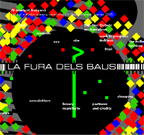
DIGITAL THEATER
Digital theater is the addition of actors and 0 and 1 bits, moving in the net. Actors in digital theater may interact from different times and places… The actions of two actors in two different times and places coincide in the network of infinite times and virtual spaces. On the 21st century, genetist conception of theater (from the generation to the birth of the scene) will be replaced by an organization of interactive and intercultural activities.
Digital theater refers to a binary language connecting the organic with the inorganic, the material with the virtual, the actor in the flesh with the avatar, the present audience with the internet users, the physical stage with the cyberspace.
The digital theater of La Fura dels Baus allows interaction on stages inside and outside the net, inventing new hypermedia interfaces. Hypertext and its protocols create a new kind of narration, closer to thoughts or dreams, generating an inner theater where dreams become (virtual) reality.
Internet is the realization of a collective thought, organic and chaotic, that has been developed with no defined hierarchy. Digital theater multiplies in thousands of representations where cybertheater fans may display images of their own subjectivity, within shared virtual worlds.
Will digital theater perpetuate Phallocracy? Will Vaginocracy eventually win? Or will both join in perfect harmony 0-1?
In digital theater, the absolute abstraction coexists with the return to the body, that may have a sadomasochist dimension —as well as a sensual, angelical, or orgiastic dimension; or perhaps a mixture of all of them.
By definition, theatrical act involves an excess, a surplus of performance. It’s the pleasure of showing and being shown. An identification flow is established between the actor and the audience. How does this identification work in digital theater? How does a hand fit into a glove? As an extension of oneself? With the integration in the net?
Digital technology makes the old dream of transcending the human body possible. Thus, cyberspace may be inhabited by bodies with a new representational envelope, between subjectivity and materiality.
We have to leave our own skin to penetrate into a common perceptual reference. The roles of the actor, the author and the audience tend to merge.
Digital culture does not belong to a reproduction technology anymore, but to an immediate production. While photography spoke in the past “it was like this”, by freezing an instant, digital image speaks in the present “it is like this”, joining the live act, the theater, the here and now.
Digital theater allows the image to mutate, from one configuration to another, actual and virtual, placing it in different stages: an icon of synthesis which will always remain HUMAN. [via]
Posted by jo at 02:12 PM | Comments (0)
SKINT STREAM
![]()
Pilot Broadcast Tonight!
Skint Stream is a network which will connect audiences and cultural spaces previously separated by economic, geographic and political factors. The use of streaming technology over existing infrastructure allows us to start a conversation between spaces separated by different types of distance.
Skint Stream consists of: • Container Project - Clarendon (Jamaica) • Sound Kitchen Studio/MMC - Johannesburg (South Africa) • Nostalgie Ya Mboka - London (UK) • Cue Music at Southend YMCA - Southend (UK) • Regent Park Focus - Toronto (Canada). You can listen to the pilot stream live on 8 June 2005 from 6pm-11pm GMT (that's 7pm-12am BST), which is: • 8pm - 1am (in Johannesburg) • 1pm - 6pm (in Kingston) • 7pm - midnight BST (in London and Southend) • 2pm - 7pm (in Toronto). (See Listen for full schedule). Skint Stream is an ICA Cape Town, Mongrel and r a d i o q u a l i a project.
Posted by jo at 01:39 PM | Comments (0)
Art at the Event Horizon

Real>>Mental>>Virtual
"Abstract: This article compares real space, mental space, and virtual electronic space that connect them. The claim is that the three topological spaces are similar to a torus. Concentrations of mass in each of the three spaces create areas that bend distance and time, like the phenomenon of a black hole. Cyberspace is the electronic unifier of the three spaces, and enlarges the event horizon (the boundary of the black hole) of human consciousness. The topology falling within the boundaries of the event horizon is a non-Euclidean geometric distortion in the style of Riemann, and Einstein’s general theory of relativity. A new examination of these phenomena using technical tools, leads to a different view of concepts, mainly post-modernistic, such as: simulacra, schizophrenia, hyper-reality, hyper-space, hyper-spectral sound and image, that today dominate the real world view, and the definition of cyberspace and human consciousness, and art. Cyberspace is the extension of the human brain that creates integrated consciousness." From Art at the Event Horizon by Avi Rosen.
Posted by jo at 09:40 AM | Comments (0)
Eliza Redux
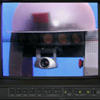
Turbulence Spotlight
Eliza Redux features a physical robot which, having passed the Turing test with flying colors, thinks it is a human psychoanalyst and persists in offering online pseudo- psychoanalytic sessions. Please help us to bring this robot to its sensors. Peer consultation is available in the Reception Area as well as archived sessions and other reference materials.
This human-robot interaction project is inspired by Joseph Weizenbaum's 1966 M.I.T. computer program ELIZA, which allowed for text-based human conversation with a computer playing the role of a psychotherapist. Weizenbaum's program was not meant to demonstrate intelligence, but to engage the user emotionally and intellectually in a simulation of artificial intelligence. In spite of the transparency of the program's lack of intelligence, lab personnel were unable, or unwilling, to distinguish the machine from a human psychotherapist and became so dependent upon ELIZA for "therapeutic sessions" that eventually Weizenbaum had to withdraw its use.
BIOGRAPHY
Adrianne Wortzel's work explores historical and cultural perspectives in both physical and virtual networked environments as venues for interactive robotic and telerobotic installations, performance productions and texts. Recent projects have been made possible by funding from the PSC-CUNY Research Foundation, a National Science Foundation Award for developing robotics and theater, and a Franklin Furnace Fund for Performance Art Award. Wortzel is a Professor of Communication Design at New York City College of Technology/CUNY as well as a member of the doctoral faculty of the Interactive Technology and Pedagogy Certificate Program of the Graduate Center. She is also an Adjunct Professor of Mechanical Engineering at the Cooper Union for the Advancement of Science and Art where she is also the Founding Director of StudioBlue, a fully equipped arena for creating telerobotic performance productions.
For more Turbulence Spotlights, please visit http://turbulence.org/spotlight
Posted by jo at 08:53 AM | Comments (0)
Virtual Musical Instruments:
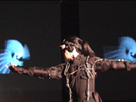
Technological Aspects and their Interactive Performance Issues
"ABSTRACT: I have been creating various Gestural Interfaces (*1) for use of my compositions in the project of Virtual Musical Instruments (*2). These Virtual Musical Instruments do not merely refer to the physical instruments, but also involves Sound Synthesis (*3) programming and Interactive Video (*4) to a great extent. Using the Virtual Musical Instruments, numerous compositions and performances were experimented. This paper is intended to report my experiences, as well as their development, instead of being merely abstract theory. This also contains the issues of performance and the problem of the notion of interactivity." Read Virtual Musical Instruments: Technological Aspects and their Interactive Performance Issues by Suguru Goto at HZ Journal.
Posted by jo at 08:28 AM | Comments (0)
At a Distance:
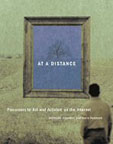
Precursors to Art and Activism on the Internet, 2005
At a Distance: Precursors to Art and Activism on the Internet, 2005 — Edited by Annmarie Chandler and Norie Neumark.—Cambridge: MIT Press, 2005.—486 p.—Includes an index.—Include a chronology of network art.—ISBN 0262033283. Reviewed by V.B. for The Daniel Langlois Foundation.
In their anthology, Annmarie Chandler and Norie Neumark assemble essays by authors who examine the networked collaborations of the 1960s and 1970s (Fluxus, mail art, cable video) as well as those of the 1980s (telematic art). Chandler and Neumark classify these practices under the heading of "distance art" to underscore the fact that they were not dependent on technological communication modes. They did, however, share a vision to utilize the space (physical, geographic, cultural, etc.) between the information transmitter and receiver in a performative fashion. And with an emphasis on programs rather than form, they introduced network art, experiments in augmented space, and the net.art of the decades that followed.
Norie Neumark's essay — which also serves as introduction — presents an overall view of the appropriation of communication tools by artists during the 20th century. The author goes on to suggest that the notion of distance could signify any combination of physical discrepancy, the time span between two events, and the division of object and subject in scientific observation. Neumark pursues her commentary by citing that the postal system was the first communication mode to close geographic distances. Broadly speaking, this system survives today, says the author, through the more sophisticated modes of technological exchange that have since emerged (telematics, Internet).
The book's first section, "Critical Perspectives on Distance Art/Activist Practices," is a collection of contributions that seek to trace the theoretic premises of these practices as they developed concurrent to the global implementation of communication modes from the 1960s onwards. The contributors assess, among other aspects, how these practices have historically been categorized according to technological progress, while the cultural contexts of their emergence and the way that participants and spectators identify with them have been largely neglected. To this end, in "Interactive, Algorithmic, Networked: Aesthetics of New Media," Johanna Drucker states that the precursors of network art reflected the technical aspects of their projects within a mainly conceptual and metaphorical perspective. By placing the accent on process rather than material repercussions or technological advances, these experimental practices allowed many artists to shed the formalist yoke of the previous decade. In "Immaterial Material: Physicality, Corporality, and Dematerialization in Telecommunication Artworks," Tilman Baumgärtel discusses the impact of exhibitions such as "Les Immatériaux," which was presented at the Centre George Pompidou (Paris, France) in 1985. According to Baumgärtel, through this multidimensional event that united theorists and artists, curator Jean-François Lyotard succeeded in defining the paradigm of an open and performative artwork. In his essay, Baumgärtel also highlights the innovative practices of the 1960s, such as the N.E. Thing Company, an entity both real and fictional created by Canadian artists Ian and Ingrid Baxter. The author states that this collective reflected the artist's public identity by parodying the protocols surrounding the exchange of economic information between a company and the outside world.
Like Baumgärtel, Reinard Braun in "From Representation to Networks: Interplays of Visualities, Apparatuses, Discourses, Territories and Bodies" reiterates the notion of dematerialization used to qualify conceptual art practices. He adds, however, that the telematic art projects of the 1970s went beyond this concept by taking into account the impact that locations transmitting and receiving information had on the significance of artistic proposals. With "The Mail Art Exhibition: Personal Worlds to Cultural Strategies," John Held Jr. addresses the problem of exhibiting mail art works. A number of representatives of the movement (including Ray Johnson) felt that these works should not become mere relics displayed in a gallery or museum. The author nevertheless makes an attempt to assemble a chronology of such exhibitions by describing the strategies used by the curators to present the works outside the network as still lively traces. In "Fluxus Praxis: An Exploration of Connections, Creativity and Connectivity," Owen F. Smith describes the sites of communication created by the Fluxus events, where communicational transparency took a back seat to humour, parody and play.
The second section presents case studies of important "distance" art projects. The studies are written either by the artists themselves or by participants who were witness to these practices. Annmarie Chandler interviews Kit Galloway and Sherrie Rabinowitz, artists who experimented with videoconferencing and satellites as early as 1970. They discuss the genesis of projects such as Satellite Art (1977), Hole in Space (1980) and Electronic Café (1984), ambitious planetary telecommunication undertakings presented to an audience that reached far beyond the perimeters of the art world. In "An Unsuspected Future in Broadcasting: Negativland," Don Joyce discusses the importance of the Negativland audio art collective of the 1980s, whose primary creative medium was the radio. One of the features of their radio show saw Negativland members inviting the public to call in and even join the broadcast (radio jamming). In "Mini FM: Performing Microscopic Distance," Annmarie Chandler and Norie Neumark interview Tetsuo Kogawa, a precursor of radio art in Japan. Kogawa describes the emergence in the 1980s of a community of young Japanese artists who used mini FM radios to communicate among one another, despite broadcasting regulations that normally filtered out this type of transmission. In "From the Gulf War to the Battle of Seattle: Building an International Alternative Media Network," Jesse Dew reports on the "Gulf Crisis TV" project, produced by Deep Dish TV Network and Paper Tiger Television (New York, U.S.A.) between 1990 and 1991. A series of cable programs documenting protests by Americans opposed to the Gulf War, the project constitutes for the author a counter testimony to the images being broadcast at the time by the mass media.
With "The Form: 1970-1979 and Other Extemporaneous Anomalous Assemblings," Melody Summer Carnahan summarizes her mail art work that began at the end of the 1970s and was derived from an alternative use of administrative procedures.
In "Networked Psychoanalysis: A Dialogue with Anna Freud Banana," Craig Saper interviews the artist known as Anna Banana, whose work drew on the paradigm of network psychoanalysis (using mail art), where participants could alternately play the role of analyst and analyzed. In "From Mail Art to Telepresence: Communication at a Distance in the Works of Paulo Bruscky and Eduardo Kac," Simone Osthoff offers a detailed analysis of the work of these Brazilian artists in the 1980s, when they primarily exhibited in South America. Osthoff studies Bruscky's fax and network art experiments and the early holography and telematic performance efforts by Kac.
"Distance Makes the Art Grow Further: Distributed Authorship and Telematic Textuality in La Plissure du Texte" by Roy Ascott recounts the collective writing experiment of 1983, which used the ARTEXT electronic textual network to capture the imagination of participants in cities around the world. In "From BBS to Wireless: A Story of Art in Chips," Andrew Garton discusses his involvement in various network projects, interweaving an autobiographical account into a history of communication technologies that he would use successively throughout his career. With "REALTIME-Radio Art, Telematic Art, and Telerobotics: Two Examples," Heidi Grundmann comments on a series of radio programs that she has curated and produced for Kunstradio in Austria since the 1970s. She also discusses the origins of the CHIP-RADIO (1992) and REALTIME (1993) projects, telerobotic musical performances that saw musicians play using motion sensors to remotely activate their instruments.
The third section focuses on the impact of the network on the art in the decades examined earlier in the publication. Contributions to the section study the emergence of artistic communities created through communication technologies. In "Estri-Dentistas: Taking the Teeth Out of Futurism," Maria Fernandez applies the notion of network as defined by theorist Armand Mattelart to examine the literary projects of the Mexican group Estridentistas, who produced works in their own country between 1920 and 1930. Among the group's influences were the Italian futurists. The author explains that the technological tools of the era were not directly accessible to the members of Estridentistas. However, they experimented with writing techniques inspired by their observations of communication and transport modes (telegraph and railway), which at the time constituted networks that bridged the physical distance between two points.
With "Computer Network Music Band: A History of the League of Automatic Music Composers and The Hub," Chris Brown and John Bischoff write about their use of telematics in musical improvisation and composition. The "League of Automatic Composers," which they created at Mills College, Oakland (California, U.S.A.) in the 1970s, was a precursor to today's widespread networking of computers by musicians and composers. In "Assembling Magazines and Alternative Artists' Networks," Stephen Perkins analyzes the phenomenon of magazines created by artists in the U.S. and South America in the early 1970s. Perkins emphasizes that by availing themselves of underground distribution methods, the artists succeeded in circulating subversive content outside of the mainstream media and in doing so escaped the grip of the authorities (particularly in countries under the stranglehold of a dictatorial regime).
In "The Wealth and Poverty of Networks," Ken Friedman, following the example of John Held Jr.'s text, returns to Fluxus and its derivatives, this time to analyze the concept of intermedia described by Dick Higgins in the 1960s. The author adds that the creators of these networks focused on relational aspects at the expense of the networks' sustainability. As a result, very little is left today with which to chronicle their historical path.
"From Internationalism to Transnations: Networked Art and Activism," by Sean Cubitt, underscores the extent to which the highly diverse political and social contexts of the collaborative projects impact their significance. Within a broader perspective, Cubitt maintains that the globalization of capital has the paradoxical effect of producing marginal networks that reinforce cultural particularities (demonstrated, says the author, by the artistic practices emerging from these networks).
Finally, the anthology includes a conclusion by Annmarie Chandler and Norie Neumark as well as a chronology of the role played by the network in art between 1921 and 2001, which encompasses all of the projects studied by the book's contributing authors.
Posted by jo at 07:00 AM | Comments (0)
June 07, 2005
Heartbeats
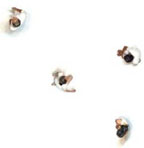
Trapped Between
"The first work that caught my eyes at WRO 05 was an interactive installation called Heartbeats by Orna Portugaly, Daphna Talithman and Sharon Younger (2004). Heartbeats is an installation in which, by letting yourself interact with a machine, your own interaction with other human-beings comes into focus. In the centre of the installation is a round table onto which four beautifully filmed video figures, captured from above against a totally white background, are projected. As four touch screen stations surround the round table, a visitor, when placing his/her fingers on one of the touch screens, becomes assigned with one of the video figures. Awaken, the video figure starts engaging in repetitive movements. The pace of the movement is controlled by the heartbeat of the participant, captured by ECG via the touch screen, and the figure is caught in its own repetition until it meets another video figure..." From Between Art and Technology by Sachiko Hayashi at HZ Journal.
Posted by jo at 02:40 PM | Comments (0)
Invisible Villages: Technolocalism and Community Renewal

The Public Realm and Decentralised Power
"...The ideological battles of the 1970s, '80s and '90s not only positioned 'public' and 'private' as mutually exclusive, but often as adversaries to one another. Similarly, the liberal ideal of equality through fairness seems equally difficult to uphold unless fundamentally organised around a single and centralised law-issuing body. Three hundred and fifty years on, it is difficult to conceive of a philosophical replacement for Thomas Hobbes's original vision of the modern state in which its legitimacy resides, at least in part, in its incontestability (Hobbes, 1996). How can a society be fair if there are competing centres of power, with potentially incommensurable notions of fairness? How can there be multiple sources of authority, and multiple public spheres, without that risking a ghettoisation of civil society?..." From Invisible Villages: Technolocalism and Community Renewal by William Davies and James Crabtree, Renewal, Vol. 12 No1 2004.
Posted by jo at 12:21 PM | Comments (0)
Interfacing/Radiotopia/KeyWorx
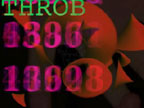
Translocal Exchanges
Interfacing/Radiotopia/KeyWorx consists of one space that has no images and has only sound, and one space that has no sound and only images. They are connected both physically and via the Internet.
SPACE 1: [Radiotopia] Walk into a theatre and enter an audio space with no images. Artists from all over the world are asked to send in audio material to fill up a database. Behind every sound is an idea, a world of words and definitions. The one big experience with Radiotopia is the peaceful confrontation of all the world's sounds, audio artists, concepts, sights and sometimes ideologies. In the Scapino theatre, the sound is mixed live by musicians and resent as an audio stream.
SPACE 2: [KeyWorx] Walk out of the theatre, down a narrow hallway and enter a space filled with images. Three artists sitting in the space, are connected with three artists in New York City. Three translocally linked pairs, three simultaneous and connected performances.
Behind every sound is an idea, a world of words and definitions. In the KeyWorx space, one listens to the world of words within the audio–spoken words, ideas, emotions, memories–and translates that world into actual text.
Inspired by a Surrealist game 'Parallel Stories', a word sent by performer or public from a mobile phone in response to the audio appears simultaneously in all three performances. Each performance pair responds to this foreign text input sent via 'sms' by creating a visual story around it. Three parallel translocal exchanges within one physical space (a room in New York, the V2 bookstore) are connected by the same word yet are unique in the visual interpretation of it. The performance is improvised and created collaboratively in real-time.
These compositions are projected onto the screens throughout the V2 space.
Want to know how we put this performance together? Follow the process log.
Credits: Concept KeyWorx Space: Isabelle Jenniches and Michelle Teran with Sher Doruff • KeyWorx performers: Isabelle Jenniches, Arjen Keesmaat, Lodewijk Loos, Eric Redlinger, Michelle Teran, Dan Vatsky
• Radiotopia project created by: Rupert Huber, August Black and Norbert Math KeyWprx project created by: Waag Society for Old and New Media.
Posted by jo at 11:57 AM | Comments (0)
2.4_interference_interaction
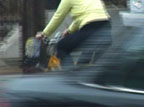
Interaction Defined by Interference
2.4_interference_interaction by Michelle Teran: A wireless, networked play space is constructed from cameras, bikes and public monitors in stores, banks and cafes. The movement and flow of an urban environment is captured and transmitted by wireless cameras connected to moving bicycles. The interaction and interference of flow when travelling through the city is visualized and broadcasted from television sets at local businesses, blurring the boundaries between interior and exterior spaces.
The cameras transmit wirelessly on the same frequency and interfere with each other. This collision of radio waves translates into distorted and volatile real-time editing of video and audio viewable on a monitor within range. Interaction is defined by interference. Either entering as a cyclist or non-cyclist, the public becomes engaged with a network where negotiations between people and hardware, cross signals culminates in a continuous spatial-temporal state of change.
Posted by jo at 11:50 AM | Comments (0)
1000
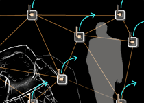
(little tips of communication)
1000--by Usman Haque with 5050 ltd--is a collaboration with wearable computing designer Despina Papadopoulos to develop a device and a system that account for technologically-aware bodies in technologically-animated spaces. The project incorporates current and near-future technologies like RFID, GPS, smart dust and smart fabrics to explore the relationship of technology, social bodies and environments. The purpose of the project is to explore actual usage of non-precious technology while at the same time challenging established traits of ubiquitous computing approaches.
In the past 10 years we have witnessed a series of projects that explore the relationship between technology and space or technology and the body. Yet few, if any, have attempted to align the two approaches and investigate the technological body in a technological space. The project synthesizes these two tracks of exploration and develops a system where both the "social body" and "space" are participating in an interactive dialogue.
Posted by jo at 11:39 AM | Comments (0)
June 06, 2005
Database of Virtual Art
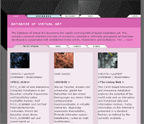
Thesaurus of the Database
We are pleased to announce the release of the extended Database of Virtual Art. It now provides an enlarged set of features and research opportunities: The major novelty is the freshly implemented Thesaurus featuring a variety of categories and keywords. The Database offers an extensive search tree that permits a targeted set search: e.g. genre: interactive art or theme: body.
The Thesaurus of the Database constitutes a new approach to systemize the field of Digital Art and the terms and concepts connected to it and will grow over the next few months. We encourage your remarks and suggestions! As a pioneer in the field, the Database of Virtual Art has been documenting the rapidly evolving field of digital installation art since 1999. It is supported by the German Research Foundation and various other institutions.
Our research-oriented, complex overview of immersive, interactive, telematic and genetic art has been developed in cooperation with renowned media artists, researchers and institutions. The database is based on open-source-technologies and allows individuals to post material themselves. Currently it contains hundreds of work descriptions including several thousand digital documents, technical data, institutions and bio-bibliographical information about the artists. As one of the richest resources available online, the database responds to the demands of the field.
Video is especially able to document the processual nature of interactive works. Therefore we have strategically integrated this medium into our concept since 2002. Over time the interlinked layers of data will also serve as a predecessor for the crucial systematic preservation of this art.
Director: Prof. Dr. Oliver Grau,
Oliver.Grau[at]culture.hu-berlin.de
Technical Lead: Christian Berndt, M.A.
berndt[at]kulturtechniker.de
Main Editor and Development Manager: Anna Paterok, M.A.
vkunst01[at]cms.hu-berlin.de
Video Documentation: Robert Loessl
robert.loessl[at]channel-unit.de
Institution Coordination: Wendy Jo Coones, M.A.
wendy[at]coones.net
http://virtualart.hu-berlin.de
Address:
Kunstgeschichtliches Seminar
Humboldt-University Berlin
Dorotheenstrasse 28
10117 Berlin, Germany
http://www2.hu-berlin.de/grau
Posted by jo at 05:13 PM | Comments (0)
Trans:it. Moving Culture through Europe
NowHere Europe
NowHere Europe is the event for the final presentation of the project Trans:it. Moving Culture Through Europe: Opening: Friday June 10, 6 pm, Laboratorio Scientifico della Soprintendenza Speciale per il Polo, Museale Veneziano, Cannaregio 3553.
Curated by Bartolomeo Pietromarchi, NowHere Europe recognizes creative practices in arts, architecture and urban practices that are re-defining the concept of public space. Initiated from direct field study, the project has produced a publication entitled The (Un)Common Place. Art, Public Space and Urban Aesthetics in Europe--published by Actar-Barcellona in English and Italian--which documents more than fifty artistic and urban projects and interventions realized or in the\process of realization in Europe; a cycle of three documentary films Invisible Communities, Ruins for the Future, Fluid Cities realized along three itineraries in eleven European cities and including interviews with artists, curators, architects, critics and intellectuals, depicting the context in which the interventions were realized and offering an introductory panorama of the themes dealt with in the book; and an exhibition that gathered, in the form of an archive, materials documenting a selection of the artist's projects.
From Norway to Turkey, from Spain to Bulgaria, from Cyprus to Romania, a "common feeling" has emerged, along with a shared context where artists, institutions and civil societies try out new relationships within which to seek new forms of co-habitation, comprehension and vision of the urban space. A common feeling that underlines a European specificity which, to quote Etienne Balibar, "has the capacity to speak/listen, teach/learn, understand/make understood (in short, to translate), a capacity that can be extended from a strictly linguistic one to a broader cultural level."
The "European specificity" which emerges from the artists' projects seems to be articulated in themes that deal with the dichotomy between public and private space in geographically and culturally distant contexts where the boundaries between social, individual, intimate and shared tend to blur. Artistic practices arise that call into question the traditional institutions of the art system, oscillating between political activism, manifestoes of intentions and direct action in the territory. What emerges from this specificity of approach is a redefinition of the meaning of community through a rediscovery of the urban experience as a learning practice that produces new visions and representations and an exploration of the collective symbols and memories. In terms of both artistic practice and theoretical reflections, NowHere Europe focuses on a new definition of the European cultural identity characterised by openness and by the constant redefinition of the Self in the r elation with the Other.
For the occasion it has been produced the site specific project of Cesare Pietroiusti, 10,000 unique art works distributed for free that will be presented during the opening.
Curator: Bartolomeo Pietromarchi
Mario Airò; Can Altay; Patrick André; An Architektur; Atelier van Lieshout; Baktruppen; Shigeru Ban; Massimo Bartolini; Matei Bejenaru; Irina Botea; Luchezar Boyadjiev; Eva Brunner-Szabo; Campement Urbain; Mircea Cantor; Monserrat Cortadellas Bacaria; Matali Crasset; C?lin Dan; Esra Ersen; Gelatin; Ion Grigorescu; Gülsün Karamustafa; Kimsooja; Iosif Király; Athanasia Kyriakakos; A.P. Komen & Murphy; Aydan Murtezaoglu; Lucy Orta; Osservatorio Nomade; Maria Papadimitriou; Cesare Pietroiusti; Oda Projesi; Bülent Sangar; School of Missing Studies; Škart; Sean Snyder; Simon Starling; Socrates Stratis; Anne-Violaine Taconet; Krassimir Terziev; Barthélémy Toguo; Gert Tschögl; Urban Void; Jeanne van Heeswijk; Erik van Lieshout; Mona Vatamanu & Florin Tudor; Zafos Xagoraris; Edwin Zwakman
Trans:it. Moving Culture through Europe
a project by
Fondazione Adriano Olivetti - http://www.fondazioneadrianolivetti.it/
in collaboration with
European Cultural Foundation - http://www.eurocult.org/
Fondation de France - http://www.fdf.org/
Fondation Evens - http://www.evensfoundation.be/
The J.F. Costopoulos Foundation
and
Soprintendenza Speciale per il Polo Museale Veneziano
ALSO VISIT:
http://www.transiteurope.org
http://fondazioneadrianolivetti.it
RELATED LINKS:
http://www.labiennale.org
FOR FURTHER INFORMATION PLEASE CONTACT:
Francesca Limana
Press & Public Relations
Fondazione Adriano Olivetti
Via G.Zanardelli, 34
00186 Roma
tel. +39 06 6877054
tel. +39 06 6896193?
Posted by jo at 04:31 PM | Comments (0)
Intimate Transactions
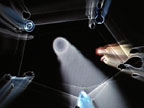
Sensory Intimacy Across Time and Space
Intimate Transactions--by The Transmute Collective--is a new type of interactive installation that allows two people located in separate spaces to interact simultaneously using only their bodies. Each participant uses a physical interface called a ‘Bodyshelf’. By gently moving their bodies on this ‘smart furniture’ they instigate ‘Intimate Transactions’, which influence an evolving ‘world’ created from digital imagery, multichannel sound and tactile feedback. This shared experience allows each participant to gradually develop a form of sensory intimacy with the other, despite the fact that they are geographically separated and cannot physically see or hear each other. As this highly immersive experience evolves, each participant begins to sense their part in a complex web of relations that connect them, and everything else within the work. In this way a subtle, indirect form of collaboration develops via an increasing sense of intimacy between sites.
Participants may choose to act in different ways as they begin to understand how their actions affect everything within the environment AND the other Participant. Hence the work focuses participants upon understanding influences and relationships within the work's ecologies.
Intimate Transactions was awarded an Honorary Mention in the 2005 Prix Ars Electronica Competition. It will next be shown in Sept 2005 at the Ars Electronic Festival, Austria and in October 2005 at the Institute of Contemporary Arts, London.
Posted by jo at 11:03 AM | Comments (0)
Multivariant Narratives
On Textuality and Narrativity
"...A truly digital text, or narrative, is one that cannot be transferred into the print medium without significant loss. It depends on the computer as a sustaining environment, and it uses the screen (or any other display device) as a stage for performance.
What, then, are the properties of digital media, and by extension of digital texts, that bear upon the development of narrative? Several new media theorists (Murray, Manovich) have offered their own lists of distinctive features or essential properties of digital systems. The list proposed below is a distillation of the features I regard as the most relevant to the issues of textuality and narrativity..." From Multivariant Narratives by Marie-Laure Ryan.
Posted by jo at 09:30 AM | Comments (0)
June 03, 2005
ACM MM Interactive Art Program
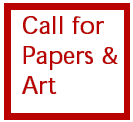
Singapore, November 2005
ACM Multimedia 2005 is the premier annual multimedia conference, covering all aspects of multimedia computing. The ACM MM Interactive Art Program seeks to bring together the arts and multimedia communities to create the stage to explore, discuss, and push the limits for the advancement of both multimedia technology through the arts, and the arts through multimedia technology.
The Interactive Art Program will consist of a conference track and an art exhibition. We invite artists working with digital media and researchers in technical areas to submit their original contributions to the following tracks:
Conference track: we solicit papers describing interactive multimedia art works, tools, applications, and technical approaches for creative uses of multimedia content and technology. Emphasis will be given to novel works that use a rich variety of media and those that are interactive, particularly works that exploit non-conventional human-computer interfaces or sensors in new and emerging areas. We strongly encourage papers with a strong technical content written by artists.
Multimedia art exhibition: "Presence/Absence." We seek art works that use multimedia to explore issues of location, relocation and dislocation, particularly where multimedia technology overcomes or reinforces physical presence or separation. The emphasis for the exhibition is on interactive art works that realize powerful artistic concepts using multimedia content and technologies. See the exhibition statement.
Important Dates:
June 20, 2005 Long papers and art exhibition submission deadline.
June 20, 2005 Short papers submission deadline.
July 29, 2005 Notification of Acceptance of Full and Short papers.
August 22, 2005 Notification of Acceptance of Interactive Arts Exhibition.
August 29, 2005 Camera-ready papers due.
Posted by jo at 02:40 PM | Comments (0)
Significant Sites - a Summer Solstice Dérive
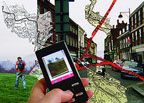
An Invitation to Participate
Significant Sites-a Summer Solstice Dérive is inspired by the Situationist practice of dérive. John and Cathy Rogers set out to chart the layers of place that make up High Wycombe as it undergoes a period of transition and redevelopment. After conducting and initial period of investigation through a series of dérives and interventions they intend to stage a grand psychogeographical event on June 18, 2005 during the Summer Solstice.
A Walker will embark on a ritualistic perambulation to link up the significant sites, or Nodules of Energy that surround the town. He will use the town's matrix of ancient footpaths to achieve this circuit. Using a videophone he will send moving images to a base station in a prominent position in the town centre where they will be projected onto a screen where spectators will be able to watch the walk as it happens.
The relayed image of the walker is presented alongside a montage of archive film and present day photographs of the town together with a simulated image of the town. In addition to the video clips the walker will send reports from his location via voice and text messages.
Spectators will be able to interact with the walker giving him directions to places they consider to be significant sites and furnish him with information and folklore about the areas he walks through.
People will be encouraged to set out on their own dérives and send back images and text to the base station for projection and relay to the audience.
Posted by jo at 02:14 PM | Comments (0)
Technologies of Cooperation: A Map To a Toolkit
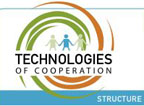
Tools to Alleviate Suffering...Liberate...Create
"What we are witnessing today is the acceleration of a trend that has been building for thousands of years. When technologies like alphabets and Internets amplify the right cognitive or social capabilities, old trends take new twists and people build things that never could be built before. Over time, the number of people engaged in producing new things has grown from an elite group to a significant portion of the population; at the same time, the tools available to these growing populations have grown more powerful.
Today's technologies of cooperation are practical tools for organizing people and solving problems that we face right now. But they are also harbingers of new forms of social and economic organization -- forms that may help resolve some of the complex social dilemmas that confront the world. So each example of a cooperative technology is also a model for thinking about future social forms as well as future tools; each example embodies principles that can help us think more strategically." From Technologies of Cooperation: A Map To a Toolkit by Howard Rheingold, theFeature, Jun 02, 2005.
Posted by jo at 01:50 PM | Comments (0)
Ange

Musical Ribcage
Ange, designed by Danielle Wilde, is a body mounted series of "ribs" with electronic sensors that enable a user to play different sounds, including breathy notes, a gong, rushing water, drums and an oboe. The notes respond differently to pressures. The idea is to use the body as an interface and allow the user to metaphorically touch and "play" the body of the wearer. The design is inspired by an 18th century engraving, Ange Anatomic by Jacques Fabien Gautier d’Agoty. [via near near future]
Posted by jo at 09:22 AM | Comments (0)
PERFORMANCE ART EDUCATION
Performing Identity
Performance artist, art educator and Franklin Furnace Alumn Dahn Hiuni has completed new research in a doctoral dissertation titled PERFORMING IDENTITY: THE POLITICS AND PEDAGOGY OF WITNESSING THE SELF.
ABSTRACT: Within the heritage of Western art, an historical shift has occurred with respect to representations that address the self. The traditional self-portrait, dominant in the modernist era, has in recent years given way to the postmodern practice of performance art. This study examines performance art as a means of exploring identity. In particular, it investigates the unique strategies that performance artists utilize to interrogate the social, cultural and political forces that construct identity and thus bear upon subjectivity. At the same time, of equal interest to this inquiry is a discrepancy that seems to exist between such contemporary practices and the field of art education. For an exploration of the latter reveals that current pedagogies remain largely faithful to earlier traditions.
Drawing on the work of postmodern and poststructuralist theorists, developmental psychologists, critical educators, contemporary performance artists and age-appropriate students, the study formulates a three-pronged theoretical hypothesis in order to explain this historical shift. The conjecture consists of the following: first, identity may be viewed more accurately as performative; second, giving and witnessing testimony has political and pedagogical implications, and; third, such practices generates criticality, which in turn cultivate personal agency. Central to the verification of this hypothesis, the author presents an original work of performance, analyzing the ways in which it corroborates itThrough this combination of methodologies, the study finds that, because of its unique use of the body as a site of discourse, and due to its ability to pose rhetorical metaphors that elicit greater criticality, performance art may yield a richer art of identity. Because of these uniquenesses, the study further finds that performance art may bear particular relevance for adolescents and young adults. As this population is known to grapple with specific issues surrounding identity formation-including race, gender, religion, sexual orientation and other forms of difference-an emphasis on performance art may constitutes particularly valuable pedagogy. For through it, students examine, verbalize, critique and renegotiate their perceived discordances within their respective socio-political realities, and thus are likely to cultivate a greater sense of agency. The study concludes that such findings expand the possibilities of an art of identity, beyond those afforded by traditional strategies. As such, it recommends that these findings be incorporated into current art education studio pedagogy.
Dahn Hiuni may be reached at dahnhiuni[at]aol.com
Posted by jo at 09:08 AM | Comments (0)
June 02, 2005
Open Nature
![]()
Panel Discussion Live on the Internet
Open Nature: Kingdom of Piracy--KOP--presents ideas and examples from their Commons R&D project. KOP were asking: how do communities self-organize to define the rules of usage of the commons? and could this process of rule making and self-organisation be modelled as a game? The work of two guest speakers gives some possible answers to these questions. Simon Yuill presents spring alpha, a networked gaming platform which 'serves as a "sketch pad" for testing out ideas for alternative forms of social practice'. Ken Suzuki presents the new electronic currency PICSY which dynamically evolves in accordance with the users' value. After the presentations, KOP moderators and the audience will join the discussion about rule making in the commons.
Date: June 4, 2005 2:00pm-(JST) + 8 hours(GST); Venue: ICC 5F Lobby; Admission: free. With: Shu Lea Cheang, Armin Medosch, Simon Yuill, Ken Suzuki, and Yukiko Shikata
Posted by jo at 08:05 AM | Comments (0)
Netzfunk

The Art of Silence
Netzfunk, a group of people working on the art of silence, is producing a soft technologies workshop in Santiago, Chile, through the end of June,for the aesthetic post-graduate program of the University of Chile. The main goal of this workshop is to transgress the apolitical view that holds sway over technological objects, altering its functional profit context to a political discursivness.
This course is divided into three practical projects, that will end with a performance in real time, where GPS and a software written on PHP for such instruments, will be used that will allow one to extend 'the' point of location on a radio to 25 meters. Additionally, the GPS will be able to download files in different digital formats (audio, text, video and images), that will match with the documents and statements obtained by the collective, which have been previously compiled. This action will be realized from three different locations in the city of Santiago. Such a piece will be the _first_ contemporary artistic work to be performed in Chile under Creative Commons license, from which it will be expected that an official launching will follow. [by Ignacio Nieto via net art review]
Posted by jo at 07:41 AM | Comments (0)
Mirror_Space

Data Portraits
The mirror provides us with phenomenal images of our appearance according to physical laws. Mirror_Space is a system of reflections of a type which involves not only optical appearances but also forces which act on us and which we cannot control affecting our phenomenal image. The person is viewed as a node which is networked with the whole of existence. Effects which can be grasped by our perception are presented in this system as dynamic data and converted into three-dimensional objects. This process also involves the compilation of a virtual image, but the filter is the calculation on the part of the computer, which not only processes our extended characteristics but also data supplied simultaneously from the world.
Users can experience their 'transformed image', which corresponds to the information supplied via a data network. The mirror image reflects the users' internal state (through image-based mood analysis) & their external affiliations (through information streams from the internet at the corresponding time, such as satellite photographs, live cam images, weather data, stock exchange data & traffic data). [via information aesthetics]
Posted by jo at 07:26 AM | Comments (0)
( ( ( N O M U S I C ) ) ) A R E N A I I

Open Call to Net Audio Players
-< 48 Players on Dual Play >-< 24h Continuous Net Audio Festival >-< Audio Live Performing only via Internet >-< Creative Commons Audio License - No Archivz >-< Stream Live Audio/Low & High >-
Stream Start: October 12 (00h00/00:00am); Stream End: October 12, 2005 (23h59/11:59pm) [GMT+0 Greenwich Time]. Join Now the ( ( ( N O M U S I C ) ) ) Deadline: September 21; Final playlist: September 28, 2005
(((NOMUSIC))) is a free platform for audio diffusion via Internet dedicated to Players. Interventions come from two simultaneous countries and follow each other in a regular manner at the rate of two peoples per hour. The development of this Network is aimed at promoting experimentation and creation.
The contributions are disseminated from different countries with two simutlaneous participants being allocated one hour in sequence, dispatched on the channel left for the Player 1 and the channel right for the Player2 , re-creating a unique stream and stereo.
(((NOMUSIC))) co-ordinates the interface for these different geographical point without any interruption, moving the audience during 24 hours from one country to the other, without jet-lag. No audio data is kept, the aim being to favour live performance throught the different stream technique in simple, multi or co-stream. The axis of development is not to constitute one dead data basis on hard disk, but to be determinedly a movement on the web where each author becomes an available data and a geophysical site that constitutes a visible tie thus during one terrestrial complete revolution foxglove.
Posted by jo at 07:18 AM | Comments (0)
Contemporary Music Review: Call for papers
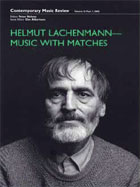
The Body/Technology–Instrument/Technology Paradigm
We invite papers from writers reflecting on sound in relation to the body/technology; from anyone who attempts to define and/or critically examine threshold conditions of instrument and performer; writers who are keen to challenge con- or discontinuities of instrument and performer, be it in the form of laptop improvisation, interactive sound environments, 3d cave installations, sonic architecture, or other performance situations.
In an era in which technology has impacted immensely on ways in which instrumental music is being performed, indeed in which the role of the instrument, if not notions of the instrument itself, have become radically altered, we want to examine the instrument’s position as well as the role of the performer.
The body/technology – instrument/technology coupling or decoupling is something that can be, and needs to be explored from various angles. Such discussion invariably leads us to think about what we consider an instrument to be in technologically mediated environments, in particular if we keep in mind that the word’s origin suggests notions of “instruction” (from Latin: instruere): who instructs or who/what is instructed by whom?
• Do we see the instrument as extension, retraction or subversion of the body?
• Is the instrument one that brings the body into existence, or one that denies bodily existence?
• What are the implications of technological environments on the instrument-performer relation?
• Does the body become re-figured and re-inscribed by technology?
These are only a few of the questions that may arise; other exploratory paths that elucidate aspects of the body/technology–instrument/technology paradigms are highly encouraged.
For this discussion papers may rejoice in the liminal, the erotic, or the incestuous, they may celebrate touch, if not the self-touch, and may move beyond notions of the instrument as extension of the body in performance.
Papers from disciplines as varied as music, philosophy, anthropology, sociology, biology, informatics or architecture will be of interest.
Abstracts of around 300 words should be sent to the guest editor by the 31st of July 2005.
Full papers will be due at the end of September 2005.
Please note: Papers are accepted only in English.
Submission of a paper to this journal will be taken to imply that it represents original work not previously published, that it is not being considered elsewhere for publication, and that if accepted for publication it will not be published elsewhere in the same form, in any language, without the consent of the editors and publishers.
All queries should be directed to: Franziska Schroeder, Guest Editor, Contemporary Music Review: Email: franziska[at]lautnet.net
Posted by jo at 07:15 AM | Comments (0)
June 01, 2005
View-Dependent Stereoscopic Projection in Real Environments
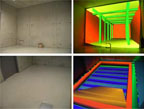
No More White Screens
This new technique in steroscopic projection callibrates each pixel that is projected onto non-planar textured and colored surfaces for view-dependant stereoscopic visualization. The ad-hoc projection opens up the potential for augmented reality environements in virtually any space, removing the need for a dedicated white projection screen or CAVEs. Imagine projecting a virtual corridor on a brick wall that maintains its illusion by removing any distortions caused by texture or color and by visualizing the depth of the corridor stereoscopically as the viewer changes position. [demo video] [Siggraph 2005] [blogged by cw wang on Future Feeder]
Posted by jo at 12:18 PM | Comments (0)
Selkirk:
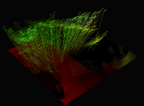
Jabberwocky Cartography of/as a Little Mind
"The moment you step into a room an ancient process of mind, functioning beyond intent and language, faster than your internal clock can say tick, will evaluate it and evoke in you a qualitative sensation. Psychogeography is the non-academic study of the way these properties of spaces are able to produce in people distinct behaviour. Scientific fact is scarce but folklore, art and literature of all times provide us with a surplus of intuitions and observations about landscape making man and not the other way around. As manmade environments, cities are of interest to psychogeographers as here the psychogeographic effect is operating in the most obvious recursive mode: the landscape designs the designer of the landscape and so on in dense concentrations of place and time." From Selkirk: Jabberwocky Cartography of/as a Little Mind by Wilfried Hou Je Bek and Orkan Telhan. Read full paper >> [via angermann]
Posted by jo at 11:50 AM | Comments (0)
Gong-tormented Sea
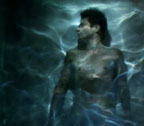
Water, Memory and Death
You are cordaily invited to join us at the opening of Gong-tormented Sea, an interactive video installation/site-specific music theatre performance by Christopher Lau & Kar Fai Samson Young. Gong-tormented Sea draws its inspiration from W.B.Yeat's middle period epic, Byzantium, a collage of classical Greek philosophical references and historical imaginations, conjuring up a tapestry of death and memory, pointing to an golden age of human civilization passed.
Gong is essentially an experimental project that depicts the elements of water, memories and death to express the above sentiment: the paradox of those who exist between the physical world's burden of living memories, and the liberty of a distant realm that is out of mere mortal's reach.
Having worked together since 2003, our interests has been to explore the fusing of traditional art form (namely performing art) with new media art and technology in various forms. The combination of music, moving images, sensor device, interactive programming, and live performances creates infinite possibilities for art expression, yet our focus has been to experiment on the use of these technologies to produce an artwork that is somewhat more poetic and closer to human nature.
Posted by jo at 08:06 AM | Comments (0)
Michel Waisvisz at CHI2005
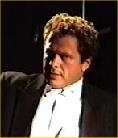
Physical Touch and Electronic Instruments
Michel Waisvisz is known for his highly physical, sensitive, and ecstatic electronic music performance using The Hands, a gestural sensor instrument that he developed at the STEIM foundation in Amsterdam. Waisvisz has since the late sixties developed new ways to achieve physical touch with electronic music instruments; sometimes literally touching the electricity inside the instruments and thereby becoming a thinking component of the machine. He was amongst the first to play with synthesizers on stage, and very early developed and performed using what are now called gestural controllers. He also is the inventor of the CrackleBox and The Web and many other instruments based on touch interaction.
Besides solo performances and composing for music theatre, he has collaborated with a great variety of musicians/composers: Laurie Anderson, Steve Lacy, DJ Spooky, Najib Cheradi, Moniek Toebosch, The Nieuw Ensemble, Willem Breuker, The San Francisco Symphony Orchestra, Maarten Altena, etc. Waisvisz is the co-founder of electrical sound festivals in Holland.
The following are unanswered questions posed to Mr. Waisvisz at the ACM CHI 2005 conference in Portland Oregon. It is our hope that Mr. Waisvisz will have an opportunity to answer a few of them for us. [blogged by Connor on HML.Blog]
Posted by jo at 07:24 AM | Comments (0)
whiSpiral
![snow2.small[1].jpg](http://www.turbulence.org/blog/images/snow2.small[1].jpg)
Embedded Memories
whiSpiral is a spiral-shaped shawl that carries whispers of your loved ones and explores how technology can enhance the way garments and accessories evoke memories of these relationships. Circuitry integrated in the textile allows your friends to record audio messages at different points in a spiral-shaped shawl. These messages are whispered back each time you wrap the shawl around yourself, or by caressing different parts of the fabric.
Each of the 9 miniature audio recording modulescan store a 10 second message. The locations of the modules are made visible by exposing some of their electronic components on the exterior of the shawl, covered by a protective material resembling 3 white leaves. A microphone connector is denoted by a yellow leaf. The whispers are released when sensors located in each audio module detect a soft caress or wrapping movement. Developed by Elena Corchero and Stefan Agamanolis when working for the Human Connectedness Group at Media Lab Europe. [blogged by Regine on near near future]
Posted by jo at 07:01 AM | Comments (0)
